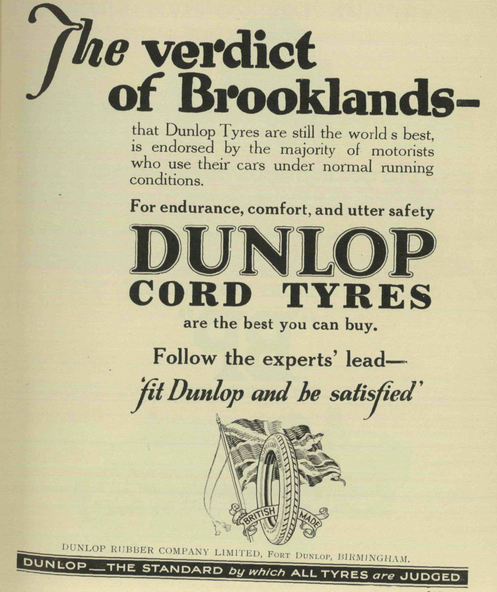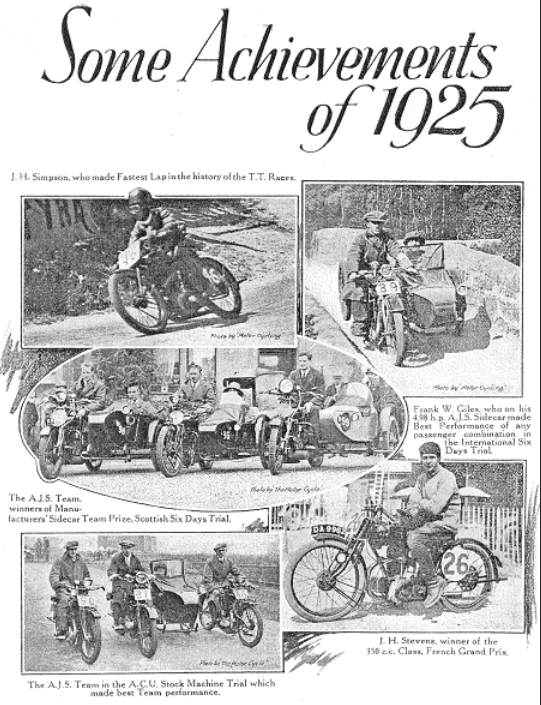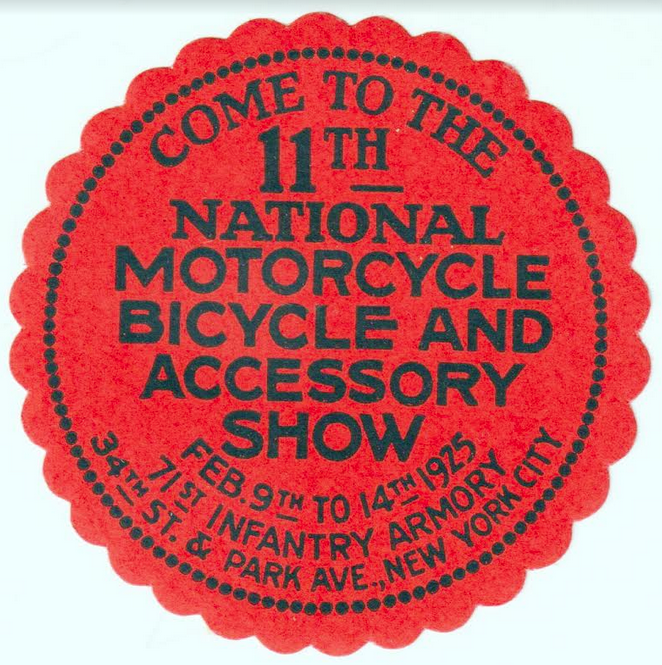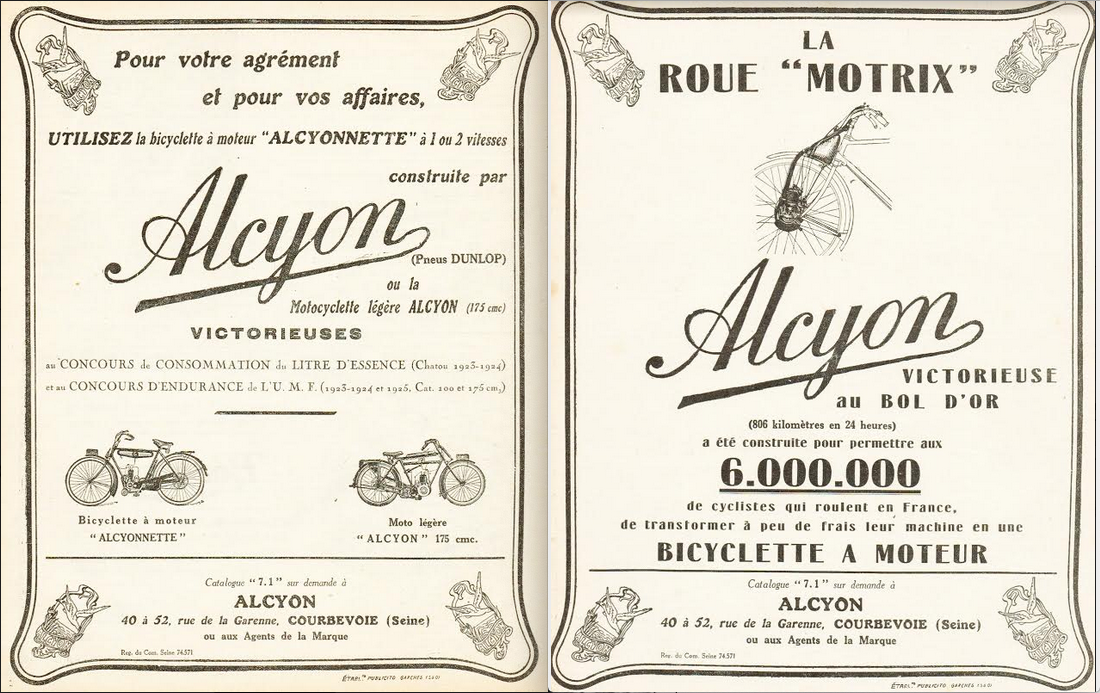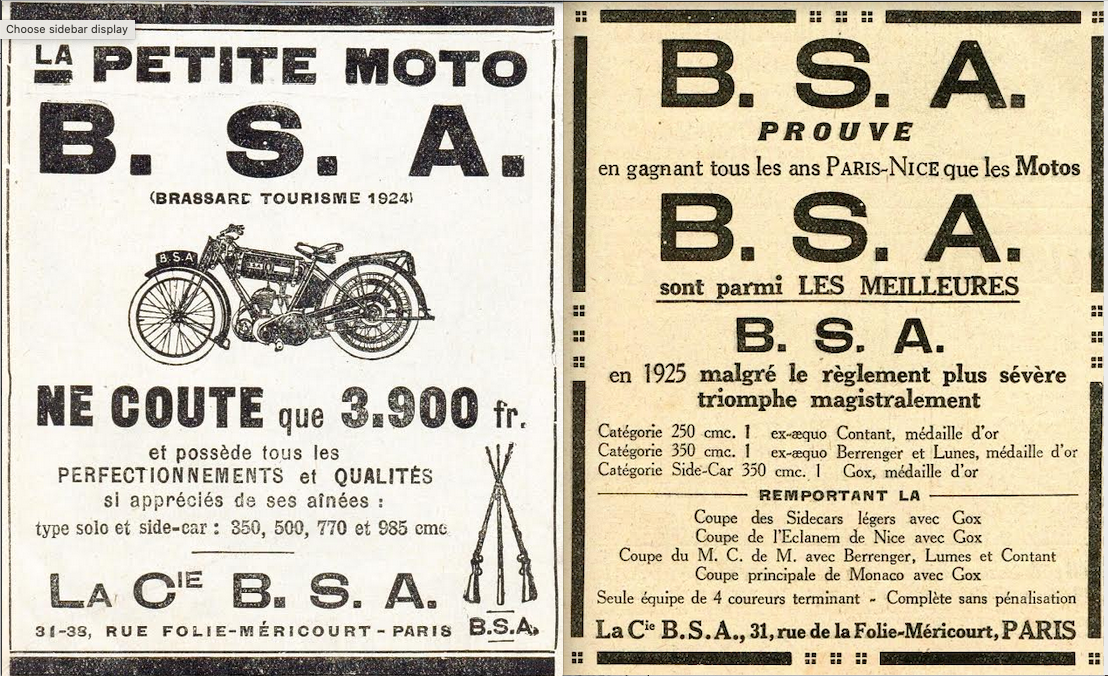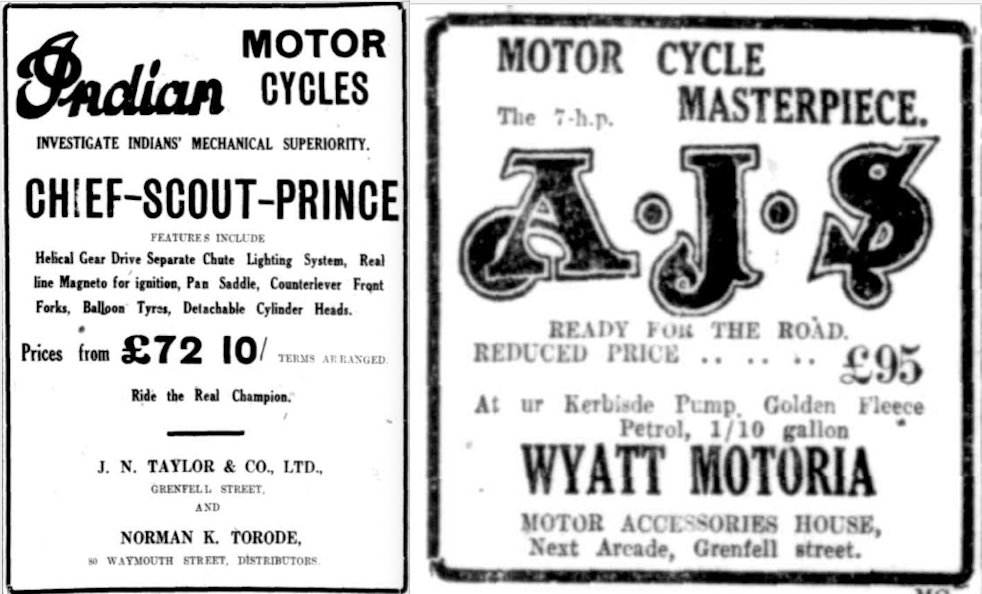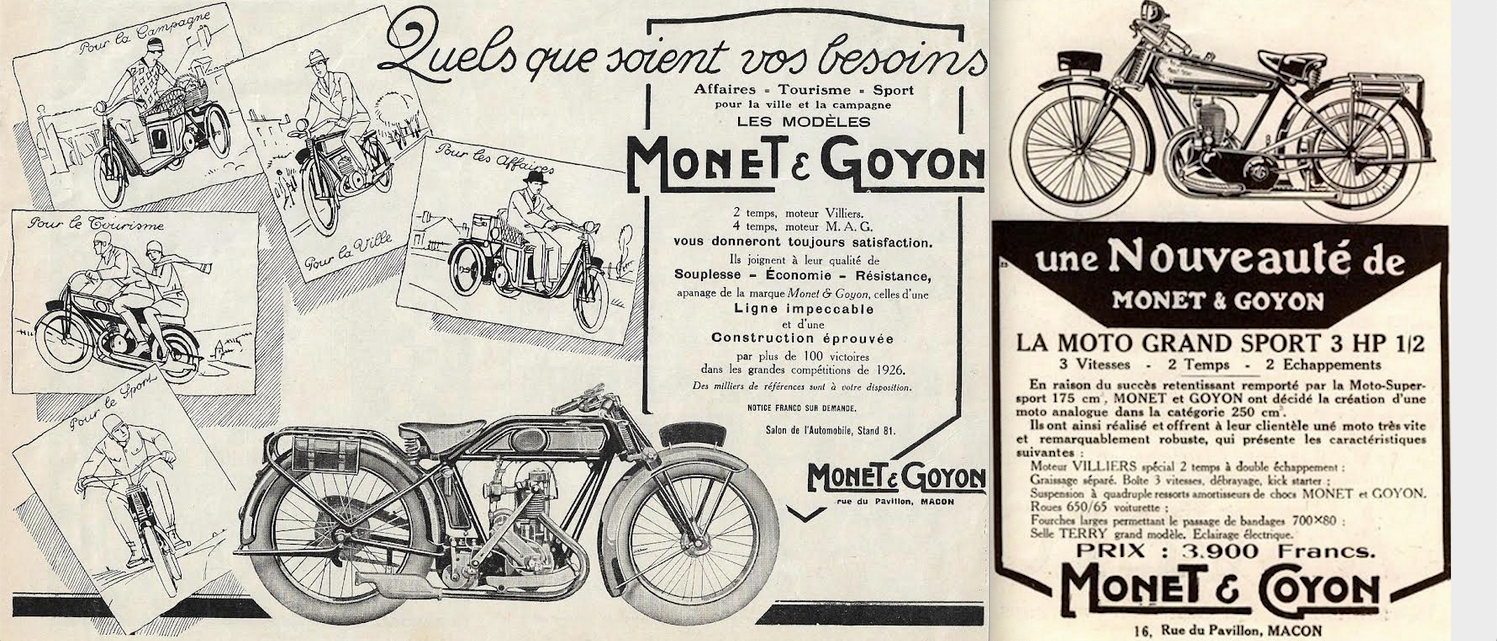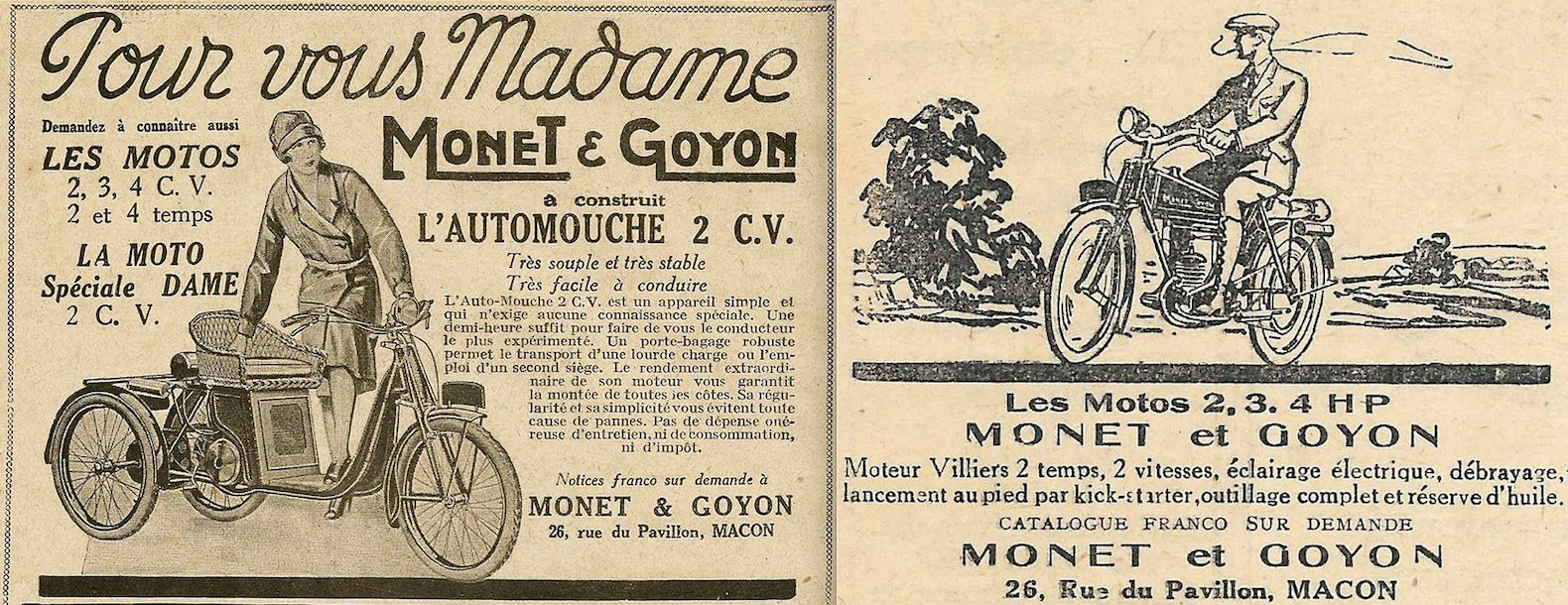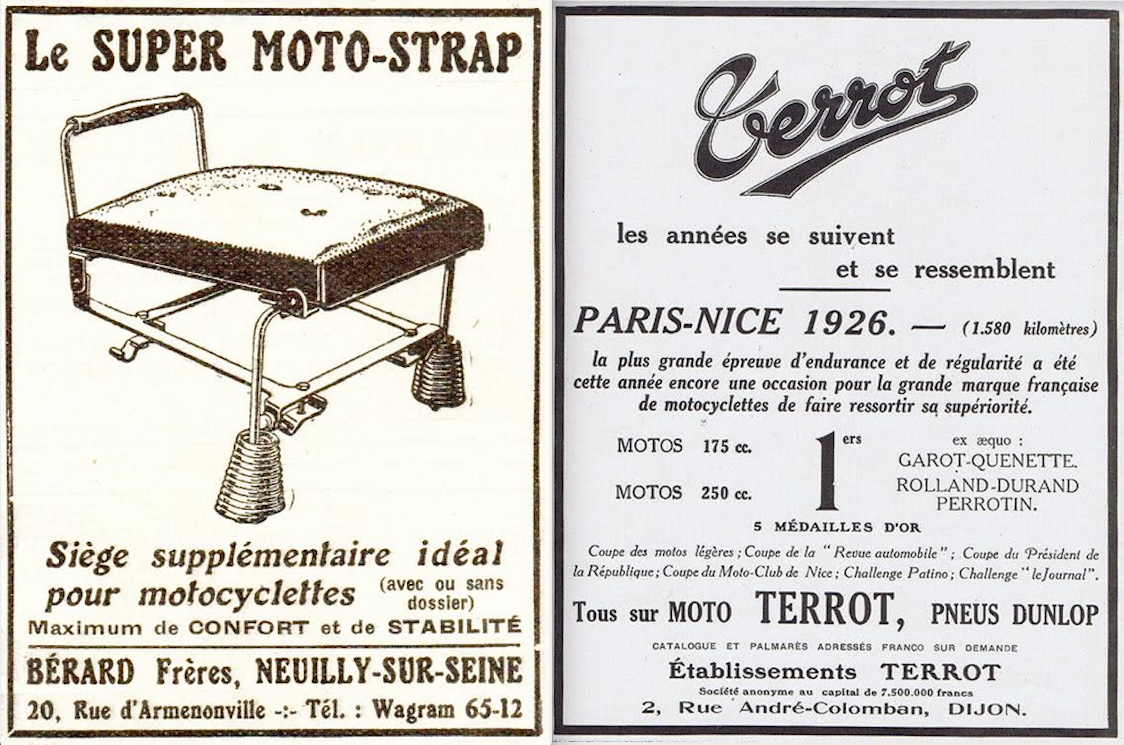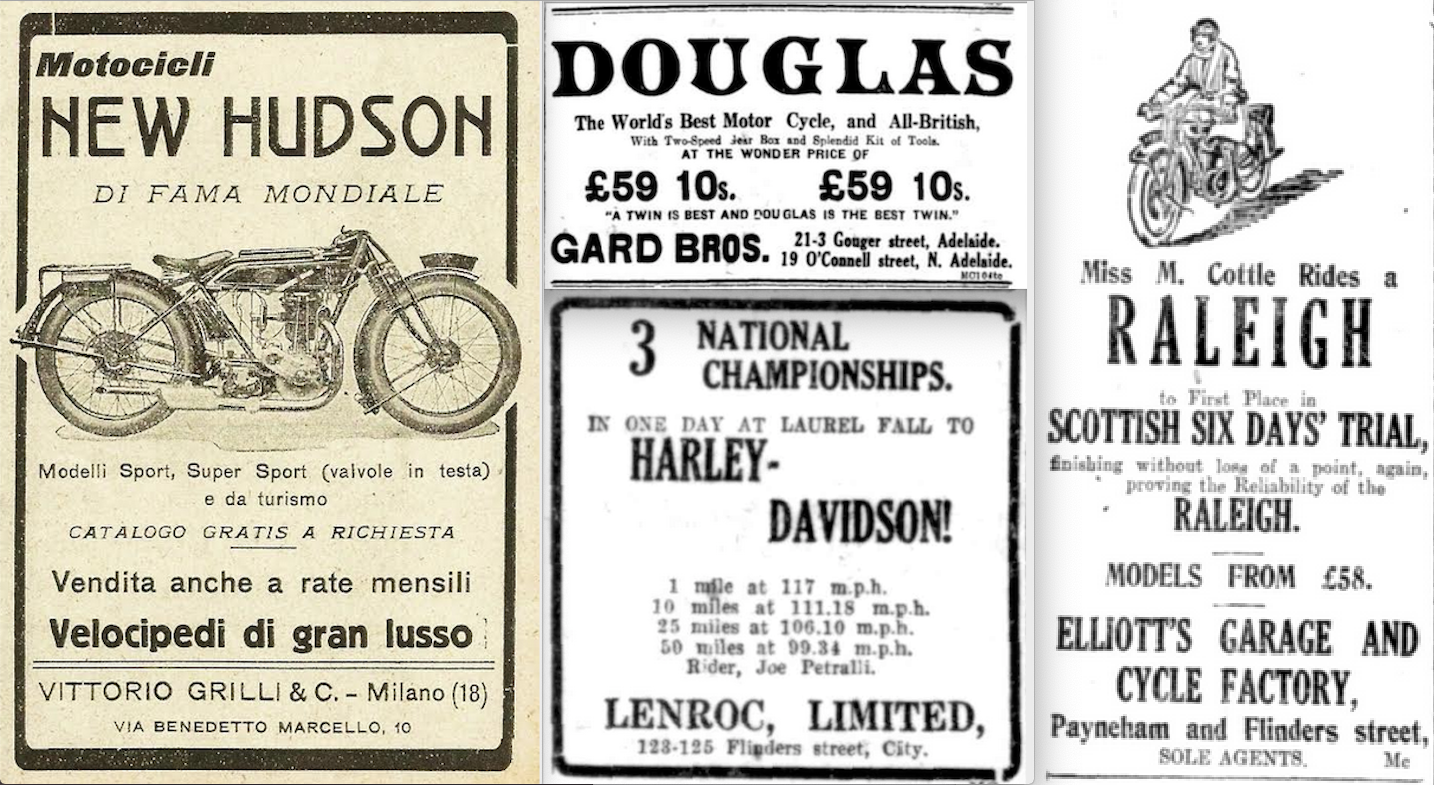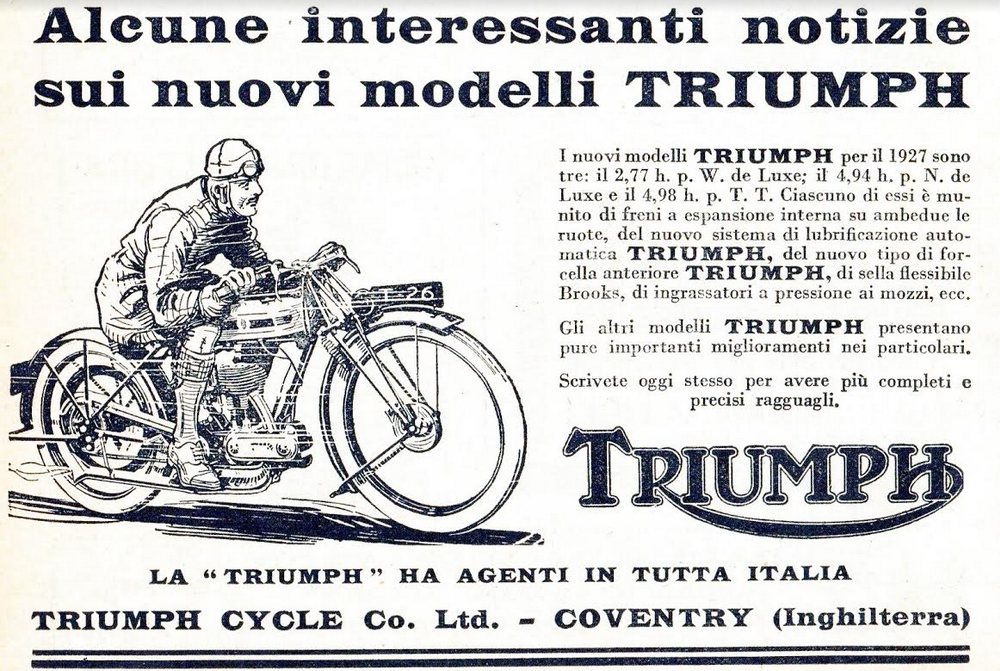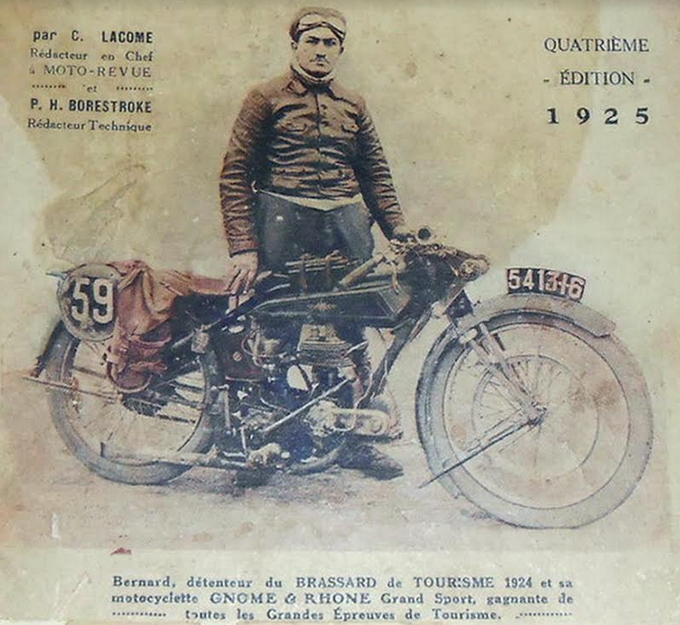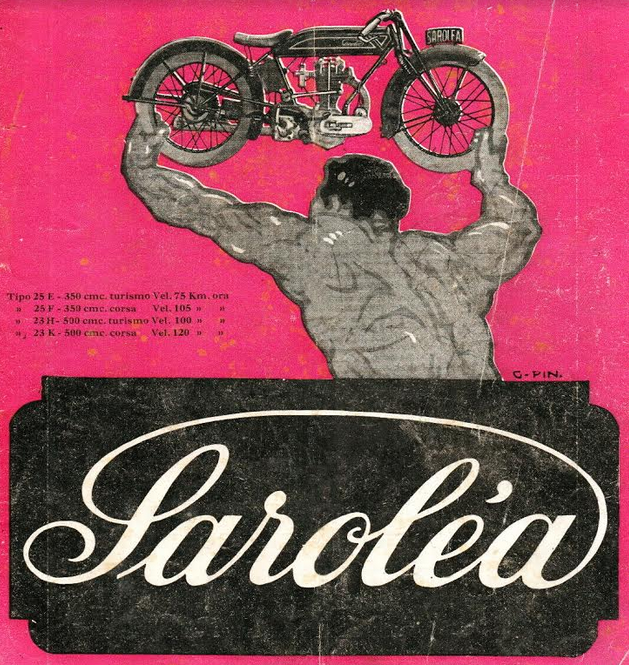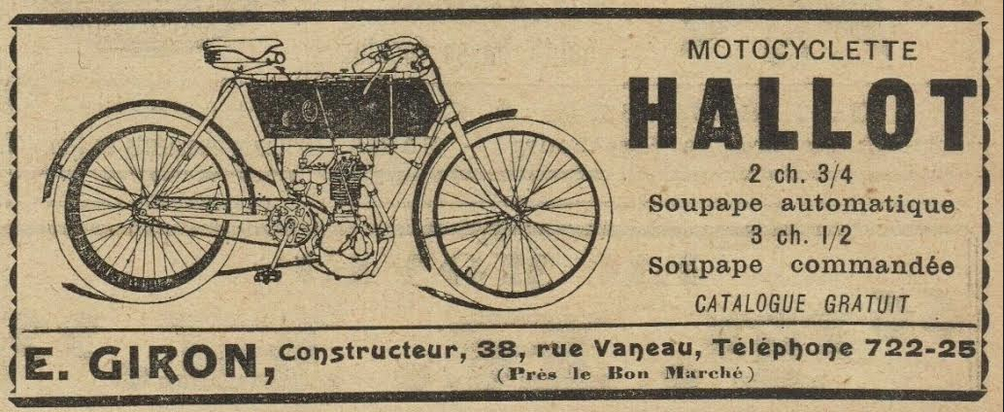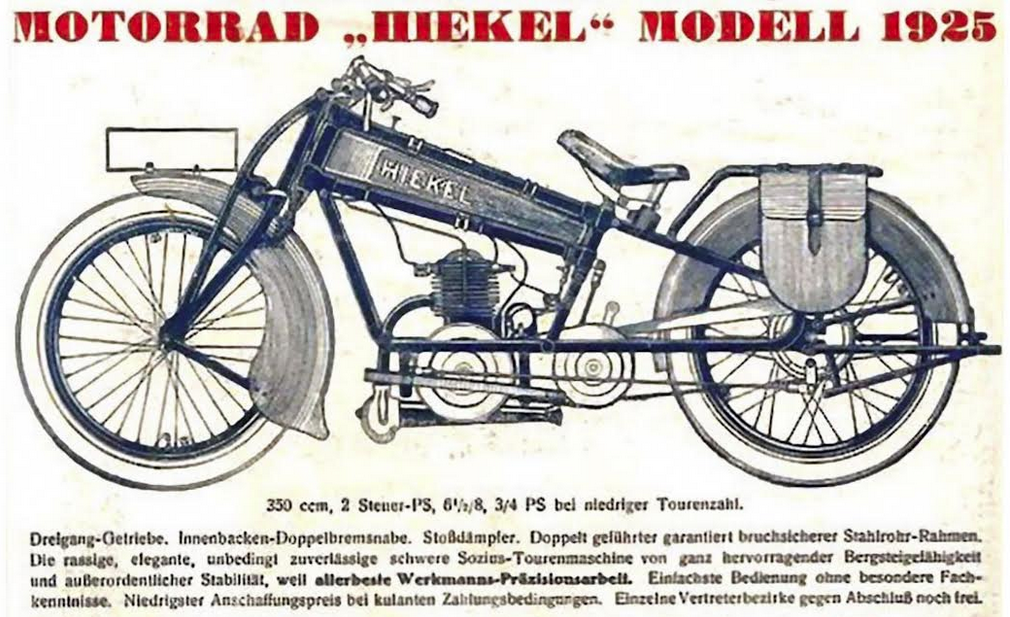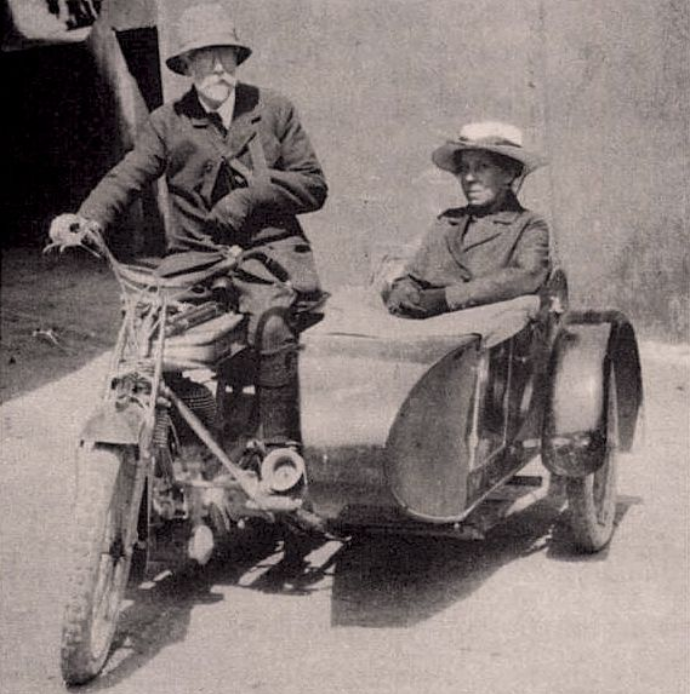
FOLLOWING A COUPLE OF YEARS in development an extraordinary motor cycle hit the streets of Czechoslovakia, taking on established marques including Jawa, Premier, Bekamo, Praga, Grizzly, Itar, Aeros, Walter, Satan, Velamos, Poustka, Koch, Sirocco, MB, Orion, Met, Velox, and JAC. The newcomer, designed by one Albin Leibisch, was marketed on its domestic market as Čechie but elsewhere it was named for its Bohemian homeland: Bohmerland. It certainly stood out from the crowd. Power, of which there was a claimed 16hp, came courtesy of a long-stroke (78x120mm) ohv single fed by an Amac (later Amal) carb, ignited by a Bosch mag and driving through a three-speed Sturmey-Archer box. The all-welded frame and girder/leading-link forks were clearly designed to withstand the roughest going; ditto the cast-aluminium ‘artillery’ wheels that would become ubiquitous half a century later. Despite being built like a tank the Bohmerland ‘Jubilee’ was said to do 80mph; the tuned and lightened Sport version came with a claim of 92mph. But Leibisch also catered for the family market with the remarkable three-seat Touren and even more remarkable four-seat Langtouren which, with a 3.2m wheelbase, must have been interesting on corners. There was also a prototype military version of the Langtouren fitted with twin Hurth gearboxes (one of them operated by a passenger) giving a total of nine speeds. The tall engine precluded the use of a convention fuel tank so five-litre pannier tanks were mounted either side of the rear wheel—the fuel pipes stretched for almost two metres. To add to the already considerable overall length, a substantial luggage box was located behind the rear wheel, suspended from extensions to the top frame rail. There were no dealers; every Bohmerland was hand-built to order and delivered direct from the factory, once it had been roadtested by its designer. About 1,600 were produced before the company’s demise at about the time the Germans came calling in 1939. In his company’s final years Liebisch developed a ‘People’s Motorcycle’ with a 350cc two-stroke engine. Bohmerland reborn! See 2019.



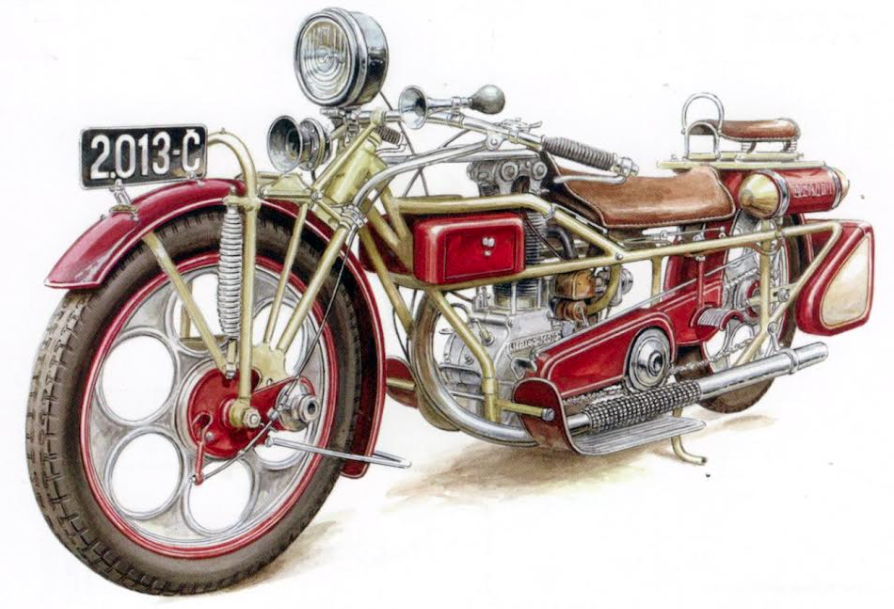
HAVING RETIRED FROM SIX TT races in the previous three years Wal Handley enjoyed a record breaking week. He became the first rider to win two TT races in the same year and he set record laps in three races. There were 52 starters in the Junior, including six New Hudsons; five Ajays and Sunbeams; four Duggies New Hudsons and Enfields; three Rex Acmes; and a brace of Howard Davies’ new HRDs. Freddy Dixon (Douglas) led at the end of lap one but Handley (Rex-Acme) was only a second behind him and took the lead for the rest of the race, winning at an average of 65.02mph which was better than 3mph faster than Alec Bennett’s winning ride in the 1924 Senior. Dixon retired, leaving Howard Davies and his HRD to finish second, ahead of Jimmy Simpson (AJS). Another AJS, ridden by CW Hough, was 4th, ahead of HF Harris on the other HRD in the race and L Horton (New Imperial). The Brooklands Gazette reported: “A more popular win could hardly be imagined than WC Handley’s triumph on the Rex-Acme. Both the rider and the firm deserve every bit of praise we can give them. Handley, who is only 22 years of age…is just the type of rider whom we all

like to see win a big race of this class. Quiet, unassuming, accepting defeat in the same spirit as he accepts victory; nothing spectacular about Handley, nothing but sheer grit and determination to place his firm’s machine at the top of the list. A wonderful rider, with an uncanny knowledge of the things that matter. To see him take the bands was a fine education, his footrest just that half-inch or so off the ground, that half-inch that makes all the difference between a fine rider with experience and the new entrant. Of the second man, namely HR Davies, we can but say that he rode an excellent race, and deserved to win as much as Handley did. Without doubt the ‘HRD’ will be a popular machine this year. Simpson, the star of the course, accomplished a miracle by winning at all; nevertheless, his chagrin was great when he discovered that he had not run into first place.. Apparently some signals had been misunderstood, which accounted for his slackening the pace…” There were only seven starters in the Ultra Lightweight TT, established only the previous year for 175s, and the field fell from 17 to seven. This could be fairly blamed on the ACU which had imposed

a 150lb weight limit. Let’s not forget that the TT had been inspired by the Continental 50kg weight limit on racing motor cycles. The very name Tourist Trophy reflected the fact that TT machines had to be fully equipped; the races were designed to improve the quality and performance of road bikes. Most of the 175s in the inaugural Ultra Lightweight TT had weighed at least 225lb. As Geoffrey Davison, editor of the TT Special put it: “…to get down to the 150lb limit entailed an enormous amount of drilling and hack-sawing! Many prospective entrants just couldn’t be bothered with this artificial weight reduction and felt that, if they got their machines down to the prescribed limits, they would be unsafe on the roads.” Rex-Acme joined Cotton, New Gerrard, Excelsior and Dot on the grid which was good news for Wal Handley as he became the first rider to win two TTs on consecutive days with a winning speed of 53.45mph. Irish rider Paddy Johnston (Cotton) was runner up with Jock Porter third on the New Gerrard he designed and built in Edinburgh (Porter and his New Gerrard had won the inaugural race). Davison remarked: “The main interest in the race, indeed, was the triangular contest between the three countries.” FG Morgan (Cotton) was fourth, with CS Barrow (Excelsior) fifth and

Charlie Dodson (Dot) sixth; N Hall (Excelsior) was the only ‘DNF’. There were no less than 11 Norton among the 47 Seniors, with eight Sunbeams, seven Douglases and, from Yorkshire, four Scotts and three of P&M’s latest ohv sports models, the Panthers. There were also a trios from AJS and New Hudson and two apiece from Montgomery and HRD—one of which, of course,was ridden by its designer, Howard Davies. Completing the field was a Triumph, a Dot, and two more designer-builder-riders: Jock Porter on a 350cc Blackburne-engined New Gerrard and (also from Edinburgh) AJ Robertson on a 500cc JAP-engined AJR. The Norton team was led by Alec Bennett, who had won the 1924 Senior; he set a lap record of almost 67mph on his first lap but finished in third place. Howard Davies won the race at 66.13mph on his HRD; runner-up was AJS works rider Frank Longman. Fourth spot went to one of the new ohv Panthers in the hands of 18-year-old P&M apprentice Tommy Bullus who had been reserve rider on the factory team until he collided with
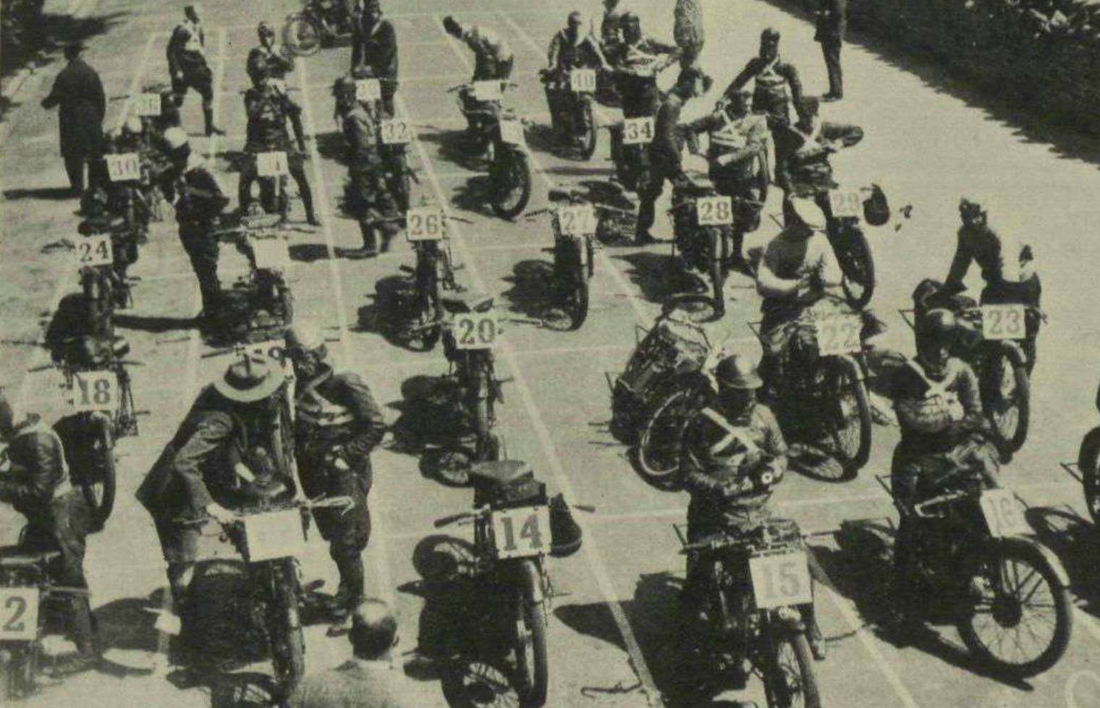
another Panther ridden by works rider Oliver Langton, crashed into a stone wall and wrecked his bike. Then Langton crashed again, broke his collar bone and Bullus was in the team. The two other Panthers failed to finish so, as footballers are said to say, the boy done good (at a creditable 61.96mph). Hard on the heels of the Panther came its Yorkshire neighbour Scott followed by a trio of Sunbeams. The Senior remained a gruelling test of man and machine—of the 47 starters there were just 18 finishers. But Howard Davies had no complaints. Since his astonishing TT week in 1921 when he won the Senior of a 350cc AJS before coming second in the Junior on the same bike Davies had failed to finish a single race. Now he had matched his 1921 record of a Senior win and Junior second place on his first TT outing aboard the HRDs he designed and built. “My machine ran perfectly and I had no trouble at all,” he told the TT Special. “The course, incidentally, was very much improved between 1924 and 1925. A lot of work had been dome on the Mountain stretch. The surface was tarred almost all the way round and there was a notable absence of stones. These improvements were reflected in the speeds of the races. My winning average in the Senior was 4½mph faster than the previous year, whilst my speed as second in the Junior was 7mph faster than the 1924 race.” The Lightweight attracted

19 250s and five of them were New Imperials. Following his Ultra-Lightweight and Junior wins Wal Handley was hot favourite on another Rex Acme and was on course for a hat-trick when he crashed following a third-lap puncture at Signpost Corner. Paddy Johnson took over the lead but a combination of lost goggles, brake failure and a leaking oil tank put him in second place behind Eddie Twemlow on one of the New Imps and just ahead of Eddie’s brother Ken on another. Handley’s first lap set a race record of 60.22mph; the first time the Mountain Course had been lapped at better than 60mph. There were 11 marques among the 18 outfits including four apiece from Douglas and Norton, two AJSs, two Sunbeams and single entries by Dot, Dunelt, New Hudson, P&M, P&P and Scott. Only six finished the course, led home by Len Parker and KJ Horstman on a Douglas at 55.22mph. Behind them came two Nortons, two Ajays and a Dunelt. The Brooklands Gazette reported: “Dixon (Douglas) and Langman (Scott) were the two giants of the practice laps, and with great expectation we looked forward to a wonderful duel;. They were both disappointing, however, for Langman fell out on the first lap with gear box trouble and Dixon, although taking our breath away for two laps surprised us by filling up with oil at the end of the second, and subsequently was reported as going badly near Ballacraine. His first lap constituted a record by being accomplished in 40min 17sec, a speed of 56.21mph. Some day he will pick a Douglas that
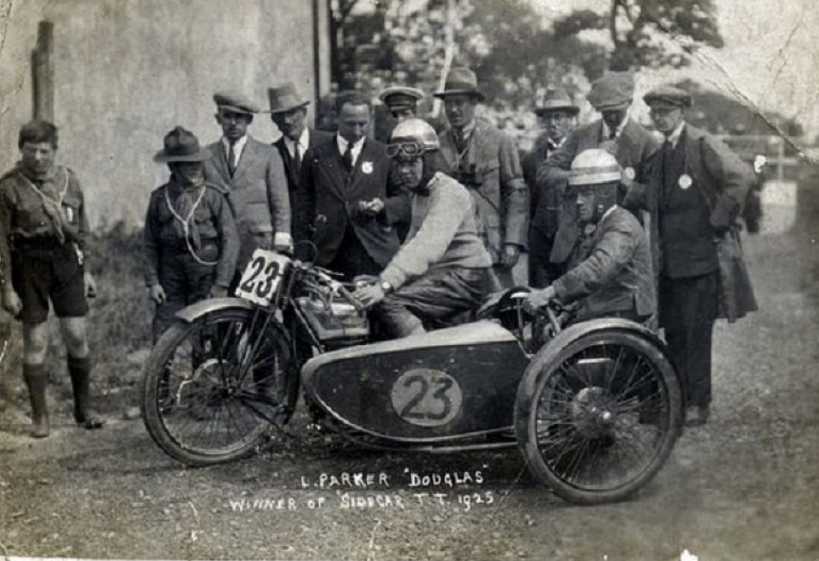
will stand up to his treatment, and TT riders for the following years will have a hard task to beat his lap times…Douglas hopes received another shaking when Hatton retired at Kirkmichael with broken front forks, and suffering from shock…Reed (Dot) retired with a faulty back brake…his passenger may have been thankful, for on the previous lap his face was literally shaved at Braddon Bridge, so neatly that his goggles were taken clean off. Perhaps we should say that he was rather roughly shaved, for certainly his face came in contact with the wall…Simpson (AJS) disappointed everyone by not finishing in under 51min 21sec, this however was due to his handlebars working loose, an incident which lost him second or at least third place…Those at the Grand Stand were treated to a real thrill by the attempt of ‘Pa’ Cowley, who is over 61 and who drove a Sunbeam, to pass Simpson along the straight. They were neck and neck at the top of Bray Hill, but Simpson being on the inside took preference in the descent…The winner, Leonard Parker, is a private entrant, and rode in 1923 in the Amateur TT, also in the Senior Race last year. His time for the last lap was only ⅘sec slower than Dixon’s record lap…AE Taylor is an amateur and is to be congratulated on coming home second in what was undoubtedly the best race of the week.”
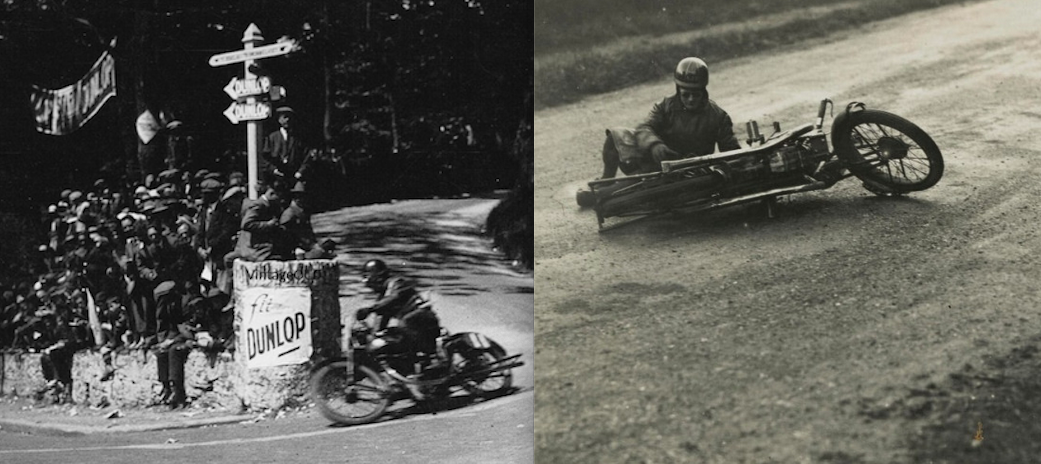
THE BELGIAN GP WAS POSTPONED by red tape. The Belgian Motor Cycle Federation banned FN for an alleged rule breach in a previous event. But FN took the Federation to court and a judge said they could race. The Federation stood its ground and simply postponed the race, while agreeing to pay the British contingent’s hotel bills and fares. To allow the race to continue FN stood down. Alec Bennett’s Norton won the 500cc class, Wal Handley won the 350cc class for Rex Acme and Porter’s New Gerrard did it again in the 250cc class. But AJS teamster Jack Hollowell was killed when he crashed into an iron gate post.
FROM THE NEW ZEALANDTRUTH: “At Sellick’s Beach, Adelaide…Paul Anderson on his Indian made a new world’s speed record of 125mph, thus beating the world’s record made by the famous English rider, Le Vack, at 123mph. During the same afternoon Anderson broke the world’s lightweight speed record on a 3½hp Indian at 103mph…The weather was dull and cloudy, and conditions on Sellick’s Beach were bad for racing, but nevertheless Anderson flew along the sands, his machine looking like a scarlet comet.” The American ace certainly got about—in the USA Motorcyclist magazine reported: “Paul D Anderson, who with his Indian has been showing the Europeans, during the past several months, what the American machine can do, has returned from Europe and is now visiting at the Indian Motorcycle Company, Springfield, Mass. He has raced and entered record trials and championships in France, Holland, Denmark, Switzerland and Italy. According to this dashing motorcycle racer, everywhere he went ‘they, across’ welcomed him with open arms and did everything in their power to make things pleasant for him…At every race meet and trials he attended, he found enormous crowds overflowing with enthusiasm. In Belgium and France, however, the race courses were so far away from the cities that the distance served more or less to keep the crowds away. The course in Belgium near Spa, was one of the most picturesque he visited. It was a 15 kilometer run; a good asphalt road which stretched itself away into the hills, meandering down thickly wooded slopes and twisting here and there like a mountain stream. There were, however, some pretty bad curves which necessitated extreme carefulness on the part of the racer…He won several noteworthy races in Holland and made many fast friends…in Switzerland he competed in the Swiss Kilometer Record Trials in the 1000cc Class and established a new Swiss two-way kilo record. His speed one way was 189km/h or 117mph and average both ways was 173km/h or 107mph…His last week in Europe was confined to France. There he signed up for the Annual Day of Records Speed Trials held at Arpajon Speedway under the auspices of the Motorcycle Club de France…This was held under the sanction of the Federation Internationale des Clubs Motorcyclistes. Paul entered both the Kilometer and Mile Record Trials, two ways and literally ‘burned-up’ the French track. The French enthusiasts gazed, awe-stricken, as the American racer opened up his Indian and ‘zipped’ over the measured distances: 159.08mph and no less was what Paul made one way in the mile. His mean average of two ways was 135.71mph. In the kilometer he straightened out a mean average of 194.59km/h or 120mph. He rode an Indian motorcycle, size 60.88 cubic inches (997.64cc). The time of 159.08mph is accredited to be the fastest ever made on wheels and therefore is a special tribute to the American-made machine and its plucky and daring rider. The Petit Parisien a Paris newspaper, referred to Anderson’s performance as a ‘wonderful and tremendous performance’ stating that the speed was such as has never been obtained heretofore by any kind of vehicle.”



THE ADELAIDE REGISTER WAS CLEARLY staffed by journalists of the finest kind: every week a full broadsheet page edited by ‘Fixit’ was devoted to ‘Motor Cycling and Club Doings’. And that worthy, having expressed his laudable devotion to motor cycles, provided the Register’s readers with an excellent summary of the year’s fastest rides, leading to the records set by messrs Anderson and Temple. He wrote like an antipodean Ixion so let’s dive into the Aussie bike scene of the mid-twenties, from news of new models to the ‘doings’ of some thriving bike clubs. All these yarns came from a single issue so motor cycling was clearly flourishing down under. Fixit, over to you:
“NO MORE A TOY!
Most motor cyclists recall the tolerant contempt of their friends who believed that they were fooling with toy engines and refused to take the motor cycle seriously. The belief lingers in some quarters, but people willing to consider facts have surrendered it. They realize that the motor cycle has proved itself no toy, but a serious and valuable means of transport in any country. It has preceded motor cars to the summit of the highest mountains climbed; it has crossed the Sahara; wild beasts in African forests have fled from the sound of its exhaust; the steppes of Russia have been conquered by it; one has gone round Australia; and snow, sand, and mud alike yield to its power. Pitted against the most powerful motor cars it has proved itself superior in speed and equal in durability. Should any part of the machinery of’ either refuse to function, the motor cycle is away on its journey again while the car driver is still searching for the cause, the reason being the immediate accessibility of all parts in the former and the absence of complications caused by a water-cooling system. In proportion to weight the motor cycle engine gives greater power than that of a car, and it loses nothing in a comparison of relative durability. It is cheaper to own and run a motor cycle in proportion to power, because of the lessened cost of tyres and the lower weight of every section.
100 MILES IN THE HOUR.
A famous British track rider on a British 1,000cc machine covered 100 miles in just under an hour at the Montlhery track near Paris recently. That was the first time in the history of the motor cycle movement that 100 miles an hour had been maintained for an hour, though the same rider a short time previously went within a few minutes of accomplishing the feat, which constituted the outstanding speed achievement in the motor cycle year. Four short years ago he was one of three famous speedmen making frenzied efforts to exceed 100 miles an hour over a kilometre. All three machines making that attempt were of American origin, and on that occasion the rider who has just made motor, cycle history was unsuccessful, getting within one-fifth of a mile an hour of the coveted century. It is all the more pleasing, therefore, to be able to record now that he was the first motor cyclist in the world to cover 100 miles inside the hour. One or two cars have accomplished a. similar feat, and a team of three British cars averaged over 100 miles an. hour throughout last year’s 200-mile mile race. In all those cases engines of 1,5OOcc or more, in most instances supercharged, have been used. At present British motor cycles have not employed supercharging methods, but it will be interesting to see how speeds will soar if and when riders resort to supercharging.
INDIAN MAKES WORLD RECORD.
World speed records were established by Paul Anderson on an Indian motor cycle, racing at the Arpajon (France) Speedway, on October 11. They were 135½mph, mean average speed over the mile, two ways, and 121mph, mean average speed over the kilometre, two ways. Crowding on pace in the mile, Anderson flashed into the startling speed of 159mph, equivalent to a mile in 22⅗sec. That is the greatest speed attained by any vehicle on land, and leaves Capt Campbell’s famous achievement of 150 miles an hour a few months ago far behind. The records are official. The races were held by the French Motor Cycle Club, under the sanction of the Federation of International Motor Cycle Clubs, and were electrically timed. While in Australia recently Anderson, on an Indian, at Sellick’s Beach, established a one-way record for Australasia of 125mph. Another noteworthy motor cycle speed achievement during the past year was 99.31mph by a 250cc machine over a kilometre. Fancy that, a speed being attained with such small nominal power, a thing no one would have dreamt of a few years ago. Since then 100mph was exceeded by an 1,100cc three-wheeler and also by a 750cc solo machine, 92 miles in the hour recorded by a 500cc machine, and more then 59 maintained for an hour by a 175cc machine. In addition 100mph was exceeded on the sands of the Lancashire coast, and in an Irish speed trial by 1,000cc twins, while a 500cc sidecar outfit covered 300 miles at more than 60mph. Development in Great Britain for some years has been in the direction of producing small machines with engines of. such high efficiency, that they equal the big twins of a few years ago. At the same time attention there, as everywhere else, has been given to engineering methods, which ensure longevity of every part. One result has been to attract general attention to the smaller machine, and American companies have given it a place among their products also.
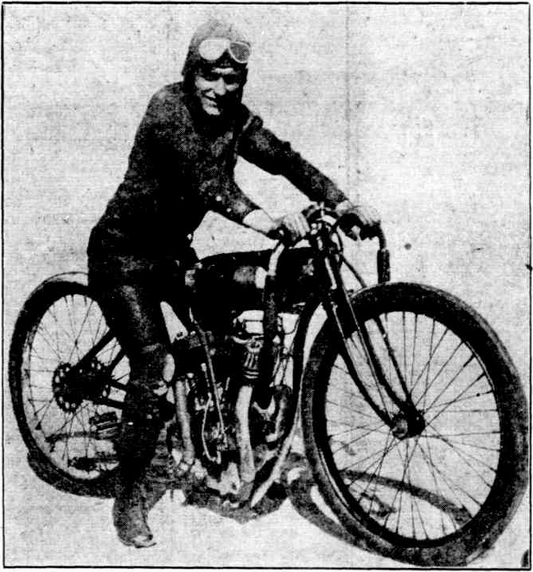
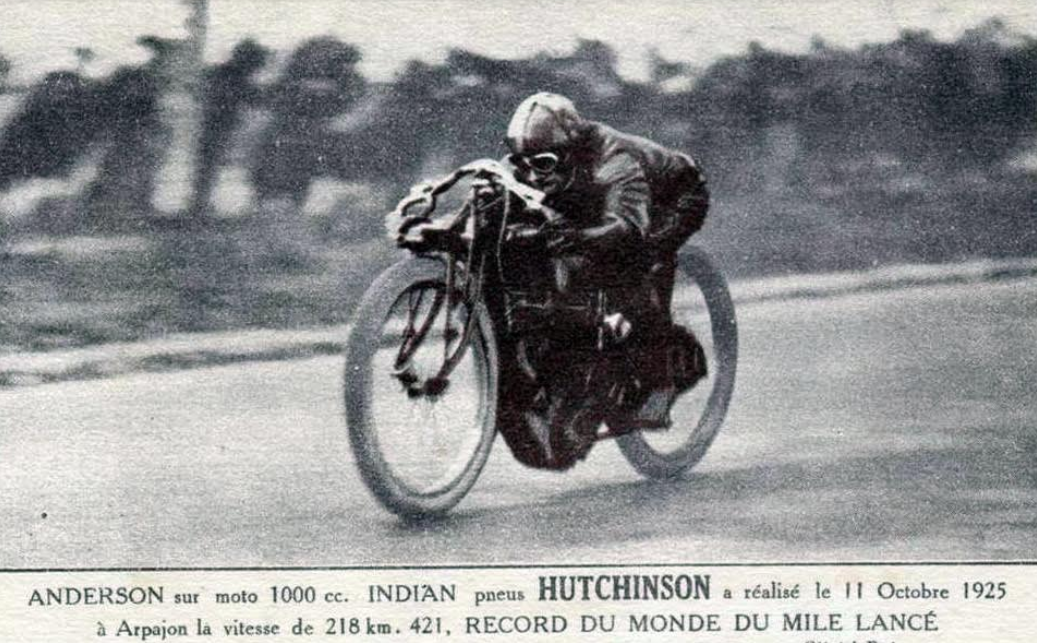

CONCULTY’S HAT TRICK.
At the Eight Hours Day meeting at the Penrith Speedway [30 miles west of Sydney, NSW] Douglas motor cycles delighted 10,000 spectators by winning three events and creating two new track records. The spectators anticipated great things, but the wonderful riding of Billy Conculty on his Douglas exceeded all expectations. Pitted against the cream of Australian dirt track riders, he won the five-mile all-powers invitation solo scratch race on a 3½hp Douglas in the record time of 4min 6sec, clipping 4.4sec off the previous record, which was also held by him. The five-mile championship of New South Wales, for machines under 500cc, was also won by Conculty on his Douglas. The five-mile under-350cc handicap was won in the record time of 4min 22.4sec from scratch. That was a wonderful speed for a 2¾ hp engine, especially when it is considered that the distance was covered from a standing start. Right from the outset the Douglas figured from scratch in every event, conceding considerable starts to motor cycles of double the horsepower.

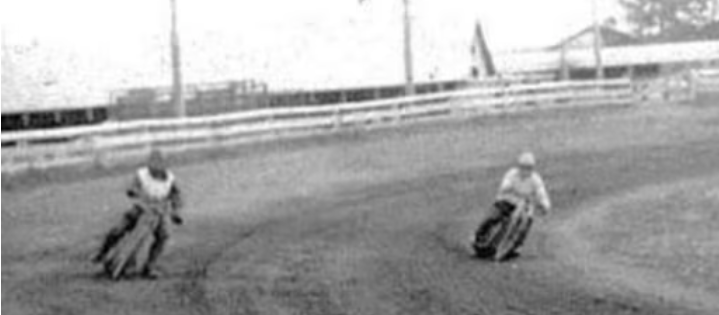
NEW MODELS OF CHATER-LEA.
Rumours have been current for some time of an intention on the part of the assemblers of the Chater-Lee motor cycle to instal a new type of engine. The reason was difficult to discover, because the Blackburne has been such an efficient engine, and was wonderfully successful in the tourist trophy races this year. For a machine designed primarily for sports purposes, it would be hard to surpass, and the adherence of other firms to it indicates the idea of its value held by engineers. However, the Chater-Lea Company is not satisfied with satisfaction, and is ready always to try for something superior. That, no doubt, is the reason which has prompted a change to a JAP engine for the 350cc machine. Apparently the change is tentative, and an extension to other models will depend on experience with the sturdy and mercurial JAP. Buyers, say the agents in South Australia (Messrs ET Fisher & Co), will be able to choose between single and double port overhead valve JAP engines for the lightweight. It may be remarked that the latter type is intended solely for racing, and the agents will not advise the selection of it for road work, for the speed developed would make the machine almost unmanageable on any except a prepared track unless a rider were an expert. Its qualities suit it beautifully for banked-track racing or attempts at records, but unless a sidecar were attached to keep the speed down it would be unwise to use it for fast touring…In all probability forks and springs have been modified on the 350cc model to meet the needs of the new engine an. expected greater speed…As a result of the experience gained when Marchant shattered so many records with a Chater-Lea at Brooklands this year, the designers were given the task of incorporating the knowledge in plans for a similar machine to be placed in the hands of the public. The new model is of 348cc, and in every respect conforms with the Brooklands type as it appeared at the end of last season after necessary modifications. That model is certain to be sought by riders who desire to’ shine on the track and at Sellick Beach…The machine also has the valve camshaft overhead, which gives greater efficiency and lessens the frequency of adjustments. That position is almost essential for high-speed machines where the pushrod is subjected to severe strains, the lessening of which becomes more important as the revolutions increase. The Blackburne engine is kept on the’ model, its value having’ been proved so’ conclusively. Evidently the company realises the risk of swapping horses when crossing a stream, and has no intention of changing engines when first giving the public a super-hotted speed demon. The famous Chater-Lea frame remains standard, and it gives a saddle position far below tankhead level, the tank having the typical streamline always fascinating when the machine is seen in a race. The sporting impression is heightened by the absence of a carrier, tool boxes being fastened to the’ rear mudguard. All-chain drive and interchangeable wheels are justified by the number of firms which adopt both nowadays. Knee grips, of course, are attachments, and shock absorbers assist the fork springs. They are of the usual type for fast machines and occupy the orthodox position just above the front mudguard. The brakes on both wheels are internal expanding, and provision is made for simple adjustment and detachment of the gear when changing wheels…Modifications include the standardization of Binks carburetters, Terry saddles, carb-jector silencers, large and. even more handsome tanks, and ingenious reversible handlebars, which allow a variety of riding position…Another entirely new production is a sports machine fitted with a 545cc sidevalve Blackburne unit. The engine has been specially tuned, and speeds of 65mph solo and 50 with sidecar are claimed.

MATTSON SETS NEW HILL RECORD.
Sweed Mattson, the speedy hill climber on the Pacific coast, went over the 65% 375ft grade on Santa Crux Hill with his 61 Indian in 12½sec. That constituted a record. Indian took first in the 61Expert, Mattson smashing the hill record. W Leighton, on a 61 Indian, took first in the 80 novice and third in the 61 novice. Luck was against Mattson in the 80 open, in, which he competed with his 61in. He turned over on his first trial and went off the course in his second attempt.
CHAMPIONSHIPS IN POLAND.
Competing in the 25-kilometre road race for the championship of Poland against a field of 50 machines, Indian won first, second, and third places. The championship was won by an Indian Standard ridden by Capt Choinski, with Robert Gunsch on an Indian Chief second and Alexander Duma on an Indian Chief third. Indian also won first and second places in. the international road race for the championship of Danzig, Poland, over a distance of 210km. Bottch, on an Indian Chief, was the winner, with Lichtenberg, also mounted on a Chief, second.
STANDARD OF QUALITY.
It is interesting to notice that when The Motor Cycle desires to indicate a standard of perfection the Norton is one of the machines mentioned by it. It is used an a standard for both road and track work, and its records during the past few years gives every justification for that opinion. Among its latest feats in Europe is a trip from London to one of the Swiss lakes (an official club tour), two being entered and both finishing. The roads encountered were extremely rough, and as a good speed was required there were many eliminations due to engine failure. The Ulster Grand Prix has been won by a Norton for the fourth time in succession. In addition to that, A Bennett established a record lap. The average speed
was in excess of 72mph. It has to be remembered that all those Nortons were standard machines, and that replicas may be obtained from any agent. The company have consistently declined to produce a special racing machine, holding an opinion that any rider must be able to duplicate any performance with his mount. The machine is simple to keep in order, and its successes on the racing track are emulated by those on the road. One, with a sidecar, went through the recent reliability trial in South Australia without losing points, and has qualified for the deciding contest next month. Some of the models similar to the new ones shown in London last month are being displayed by Messrs BT Fisher & Co in their showrooms, Grote street, and are being given a lot of attention.

WYATT MOTORIA.
The Wyatt Motoria, next Arcade,Grenfell Street, caters for the requirements of motorists. The kerbside petrol pump, from which Golden Fleece petrol is drawn, has been found convenient by motor car drivers. The many extra articles which go to equip a car or cycle may be obtained, also spare parts for almost every build of motor cycle, and oil of all grades. The Wyatt Motoria is also the South Australian distributor of the two-stroke Francis-Barnett motor cycle. There has been such a big demand for the 2¾hp AJS lately that the stock has been depleted, but new machines are due almost immediately. Intending purchasers are advised to book their orders early.

SEVEN HP AJS TWIN.
Motor cyclists who desire a high-powered machine should inspect the 7hp AJS at the Wyatt Motoria. The whole design is a masterpiece. From the twin engine 18 brake horsepower is obtained, and its quiet running allows the longest journey to be negotiated without fatigue. The transmission system permits a crawl through thick traffic and a quick getaway. The wheels, being interchangeable, may be removed in a few seconds without interfering with the brakes or chains. The three-speed gearbox, clutch, and Renold chain transmission, twist-grip control, and Binks carburetter are high grade. The tough, supple springs of the Brampton forks, and the well-sprung saddle ensure comfortable riding. The Wyatt Motoria showrooms are in Grenfell street, next the Arcade.

INDIANS MEET A DEMAND.
Under the one name, says Mr NK Torode, of Waymouth Street, an Indian dealer sells models which cover the complete range of motor cycle demand…Behind him is one of the biggest motor cycle factories in the world, building its machines more and more each year with a comprehensive eye to Australasian requirements. Australasia was Indian’s biggest overseas customer, taking nearly 50% of the factory’s total export output last year. Indian sales in Australasia are now averaging more than 4,000 machines a year. Instancing the consideration given by the factory to Australasian demands Mr Torode said that when, towards the end of last year, a Melbourne agent visited Springfield as Australasia’s representative, he was able to hold up for two months the production of’ Indian’s 1925 export models, so that features he knew to be necessitated by conditions out here might be embodied in their design. That despite the fact that on his arrival he found the tools for production already set up. By introducing Scout and Prince the Indian factory had taken a shrewd lead in motor cycle manufacturing. Manufacturers were now realising that concentration on those types, low in initial cost, low in upkeep, and yet powerful enough for all requirements, meant the way to bigger business. During the war English lightweights, which had constituted the motor cycle market up to 1914, were withdrawn, and replaced by American heavyweights, the only machines available. After the war, when manufacturing costs increased, the heavyweights came into competition with cars, said Mr Torode, and suffered. Motor cycles underwent a period of depression. Now, through the continued development of Scout and Prince types, conditions had changed. The brightest outlook ever known for motor cycles was developing in America. Production had increased, prices had fallen, and the price gap between cars and motor cycles on which motor cycle sales depended principally, was at its widest. The past 12 months had been a record for the Indian factory because it had pioneered the swing-back from the heavyweights, had gauged its limits, and had produced the types required. Australasia’s lightweight requirements were embodied in the Prince. That wheelbase, added strength in the frame, extra weight in the spokes, and features like those were essential for Australasian conditions. The Scout created and. monopolised a big section of motor cycle demand and now constituted 60% of the factory’s export output…The Indian line comprised the three stabilised types of motor cycles. Prince, Scout and Chief were respectively comparable to Chevrolet, Dodge, and Cadillac cars. They held the same position in the motor cycle market as those three cars held in thee automobile market. And they had the added advantage of selling under the. one name…The coming 12 months would be of importance to Indian, said Mr Torode, for the factory had moved on to its 25th year; the oldest in the world, with a history of progress and achievement.”
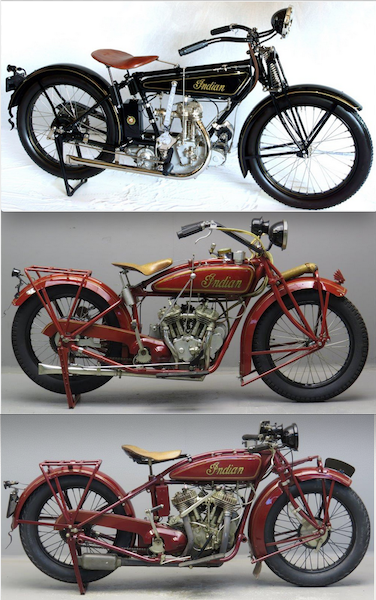
2¼HP RALEIGH.
The manufacturers of Raleigh motor cycles are now producing a 248cc capacity,’ with bore and stroke 60x88mm, large diameter, outside flywheel. Ignition, HT with handle bar control; Carburetter, Binks; lubrication, mechanical, with reverse hand pump; gear box, Sturmey Archer three-speed, handle bar controlled. Transmission by Brampton chain with chain cases; brake, two independent internal expanding, operating in rear wheel; tank of special design with one seam only; large filler caps; petrol capacity, 1¾ gallons; oil, 2¾ pints. Front forks, Brampton pattern, with’ adjustable side-links; saddle, best quality, with low riding position; foot rests adjustable, giving three different positions; mudguards front and rear, 5½ section stands, front and rear; lubrication, Enot’s grease-gun system fitted to front forks and wheels, gun supplied with tool kit; weight, 172lb. As seen by the above specification of this machine, it is complete in every way. When one takes into consideration all the latest improvements, being put on a lightweight machine which is being marketed for a very low figure, one gets a faint idea of the equipment complete with the production behind the Raleigh organisation, which is known all over the world as producers of quality machines. The sole distributors, Elliott’s Garage, Payneham and 91 Flinders Street, are now unpacking the first shipment, and. will be pleased to demonstrate at any time.

LEVIS MAKES BIGGER MACHINE.
Various companies are announcing specifications of 1926 machines, and Butterfields, Limited, of Birmingham, are among them. Their famous Levis range is to acquire a bigger brother, and full details of it will be available within a few days. Though the popular single-gear model is to disappear from the United Kingdom, it is to be produced for sale overseas, where there is a big demand for it. Messrs ET Fisher & Co report that they could sell more if they were available, and the decision to send the whole production abroad is likely to increase their business. It is a wonder that there has not been a big Levis for years, for it was the first of the successful two-strokes, and its qualities were sufficient to encourage experiments with a larger model. The Levis has disproved a theory that a two-stroke motor cycle is wasteful of petrol in comparison with the orthodox four-stroke, and its admirers will welcome the new line. In every way Butterfield productions are suited to Australian conditions, and they are proving their worth in. various parts of the State. Its latest successes include victory in the 350cc class of the Morialta hillclimb, in which its lightness was a big factor, finishing without loss of marks in the reliability trial. The agents expect to do well at the final, and are looking forward to it eagerly.
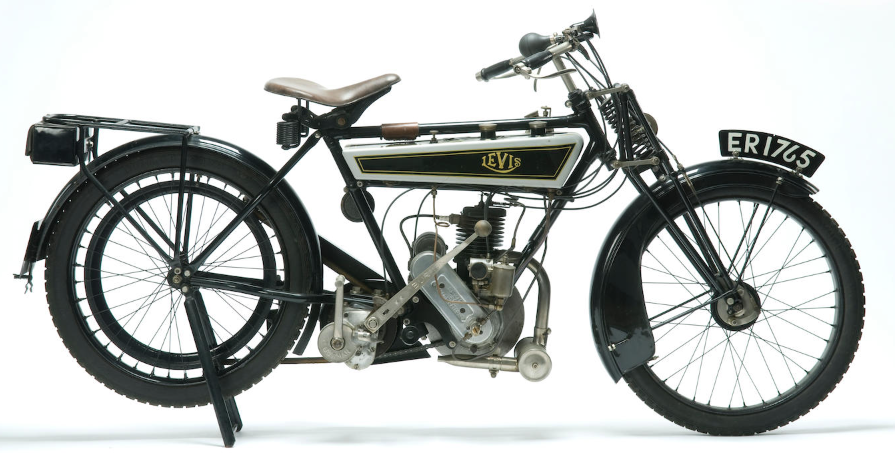
LESSONS OF SPEED.
Now that so many commercial machines are capable of really high speed in their delivery tune, perfect steering becomes more important than ever, and the vital factor is naturally affected by wheel alignment and frame truth. It is seldom safe to take either of those items for granted, though it may be done with a New Hudson. Though they are usually correct when a machine is sent out, a happy-go-lucky owner may ruin then both without suspecting the fact; quite a small toss may strain the frame, state Madge Motors and Breakdown Service, Limited of Grote Street, the South Australian agents. A bit of bad driving will haul too light a frame quite cockeyed, and a single careless adjustment of the rear chain may set the back wheel out of line with the front. Of course, the careful owner improvises his own depth gauges, and tests both items before he attempts any special speed stunts. Fortunately the agents impress the possibilities on, all buyers, and give an eye to everything when petrol is purchased. Experience has shown that an adjustment is seldom necessary, the New Hudson Company’s employees having done their work thoroughly. Interest now is sure to centre in the overhead valve models, which are to be produced in three sizes, namely, 350cc, 500cc and 600cc, during the ensuing year. Speed events in 1925 have pointed the way to various detail modifications in the machines. The pushrods are now actuated by tappets bearing directly on the cams, while the overhead rockers are carried by ball and roller bearings, lubricated by the grease gun system, an even more effective and quieter method than that it replaces. The overhead rockers are roller-ended, thus minimising thrust on the valve stems. A crankcase release, mechanically timed from the engine, lubricates the transmission shock absorber and the primary chain. The ohv machines have a low riding position, and lines pleasing to the eye. Side-valve New Hudsons—again of 350cc, 500cc, and 600cc, the last mainly intended for sidecar work—will be shown, modified in detail only. Terry saddles will be standardised throughout and all models will have an improved mechanical oil pump. Each side-valve machine will be shown in two forms, semi-sports and touring, with appropriate equipment. It is the proud claim of the manufacturers that New-Hudson motor cycles are produced in their entirety in their large factory—the floor areas of which are nearly six acres—and by means of a plant that represents the last word in up-to-dateness and efficiency. There, under control, is cut every tooth in the famous New-Hudson gears, which are expected to be in service for many years. There, also, under the supervision of expert motor cycle engineers, the New-Hudson engines are built. Each and every stage of manufacture is controlled by a highly skilled staff, bent on maintaining a 20 years’ and world-wide reputation for producing only high-class motor- cycles. The successes of the machines in competitions during the past 12 months testify to the skill of the designers, who are jubilant over the selection of a New-Hudson to represent Great Britain in the international trials.

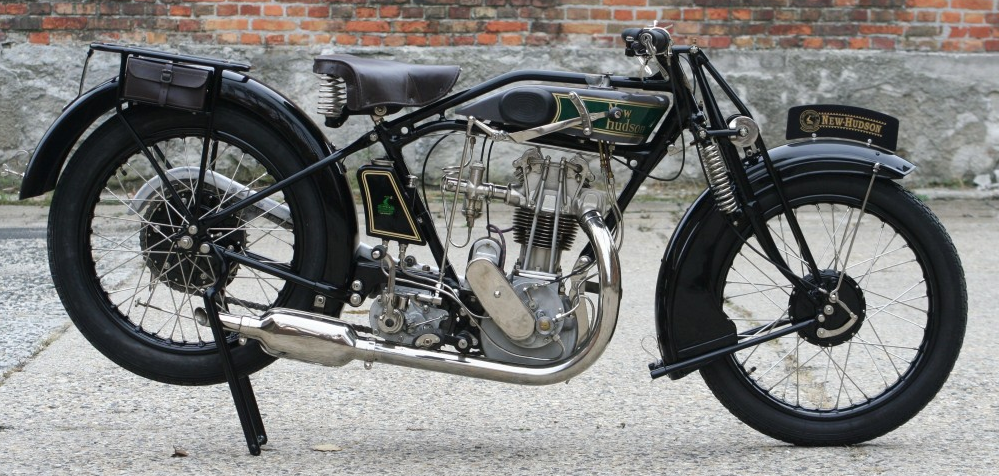
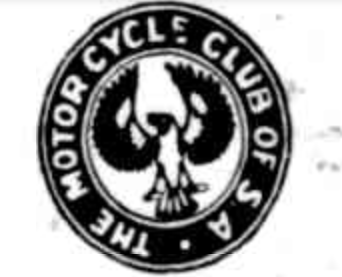
CLUB NOTES.
October 27— Social and dance, North Adelaide. October 29—General meeting. October 31—Glenelg DTNA carnival. October 31—Waikerie Racecourse meeting. November 7— 50-mile elimination trial. November— Hillclimb. December—Racecourse fixture and oral carnival. Christmas Holidays—Two-days’ Sellick’s meeting and racecourse meeting. A social and dance will be given by the club in the Royal Institution for the Blind tonight, tickets for which may be obtained from any officer or committeeman; a splendid programme has been arranged by Mr JL Koch, who has obtained the services of the Levis Orchestra. A splendid entry has been received for the Glenelg carnival in aid of the District Trained Nursing Society on Saturday. A procession is to leave Queens Statue, Victoria square, Adelaide, at 2.15 pm, whence it will proceed to the seaside town, awakening interest on the way. The Levis and Indian Clubs will be in the procession, and prizes are offered for the best-decorated outfit and fancy- costume. The club is showing its determination to punish members who take part in speed events at unregistered meetings. Three who did so recently have’ been disqualified for six months. It has been decided that for, a meeting on the Gawler Racecourse about the middle of December, there shall be the following events:— Solo, up to 400cc, handicap; over 400cc, handicap; sidecar handicap, novice handicap, light-car handicap. The novice handicap will be for members who ‘have not won prize money in a race. Novice and light-car handicaps will be included in the two-days’ Sellick’s meeting during the .Christmas holidays. As a result of 12 motor cycles and five cars having lost no points in the 125 miles reliability trial on Labour Day there will be an elimination test on November 7. Competitors will leave at two-minute intervals. Outside the metropolitan area a speed of 22mph will be averaged; the course will be secretly controlled. Competitors will lose 1 point for each 30 seconds or part thereof early or late at any point in the course, but will be allowed 30sec, early or late, before being penalised. The course will be 50 miles in length.
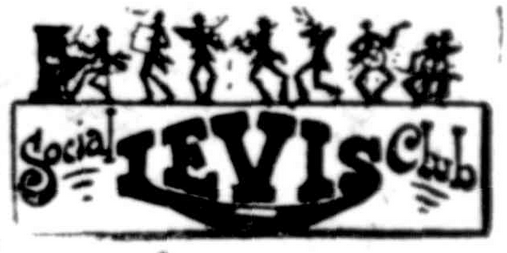
ENGAGEMENTS.
October 31— Glenelg Carnival, November 5— Fifth Creek. Members are urged to do their utmost to make the social of the senior club tonight a success in every way. The Levis Orchestra, as usual, will give its services, and Mr T King promises that it will add to its reputation. The orchestra will be in evidence in the procession to Gleneig and at the carnival there next Saturday afternoon. The funds are to be given to the District Trained Nursing Society. At the carnival the Levis broncho will give a display of its antics, and it has been suggested that a small charge should be made for a ride on it, the receipts to go into the society’s funds. It is known that there will be some events quite new to South Australia; the programme has been arranged with the object cf showing the ability of motor cycles. The first social of the season will be given at Fifth Creek on November 6. It is the intention of the committee to make the Gunpowder Plot fade into insignificance into the minds of Fifth Creek residents when compared with the visit of the club, so the arrangements are on an elaborate scale. Of course, the orchestra will be in attendance. It has been practising new items, and it is whispered that skill has been attained in imitating the noises of fireworks exploding.
ELL10TT AND CALTHORPE CLUB.
The Victor Harbour run, organised by the club recently, was enjoyable. The weather was delightful, but unfortunately several stretches of bad road were encountered. A stop was made at Goolwa for lunch, after which Port Elliot and Victor Harbour were visited. A diversion, in the shape of a stray bull caused a little trouble. The first batch of riders passed all right,, but the bull appeared to take a dislike, to the second party and became a trifle annoyed. Although it is rather early in the season the committee is expecting a big muster for the Mannum run on November 1, as the report of the roads is good. The secretary will be pleased to receive information regarding a suitable site for a hill-climb. Several hills have been mentioned, but the ideal has not been found. The hill can be either public or private property, and preferably steep, with the top visible from the base.
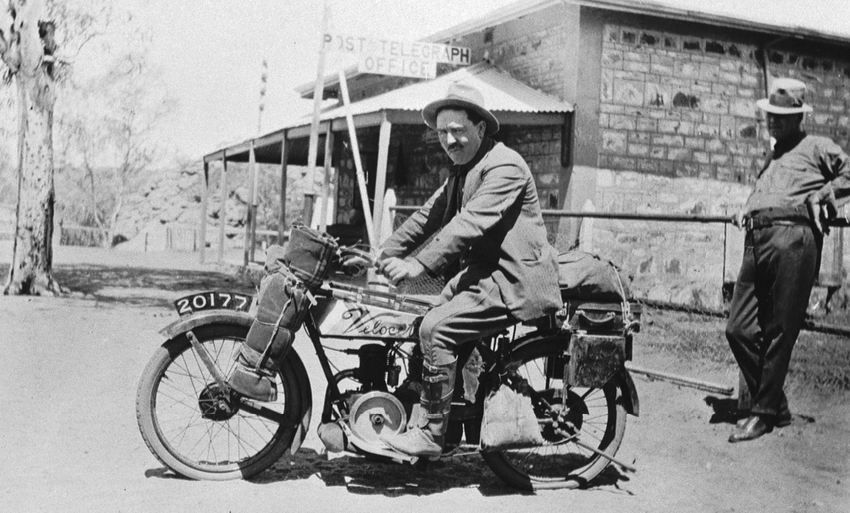
BY WAY OF CONTRAST, ARTHUR GRADY became the first rider to chose a motorcycle to circumnavigate Australia. His 350cc Douglas was loaded with 20lit of fuel, six litres of oil and nine litres of water—luggage space was so limited that he carried his toothbrush in his pocket. For much of the 9,000km he and the Duggie had to tackle brutal countryside but he was nothing if not determined: “On reaching a gorge I decided at once on a plan of action. First taking off the loaded carrier, I carried it over to the opposite bank. Next I unbolted the engine and carried that over. Finally the frame and then the wheels were brought along and the whole machine reassembled on the other side, but not without breaking two radiating fins off the front cylinder.” Soaked by the river crossing, Grady immediately ran into a bush fire: “As I rounded the hill a vast plain stretched before me and I saw thick volumes of smoke. Smoking logs had fallen across my path and the cattle pad was obliterated. Having noted the features of the landscape, I was independent of any tracks. I made my landmarks every time I left the pad and, when chance offered, cut to the pad again. In this manner I forced my way along, the smell of burning wood mingled with the fumes of heated petrol; the burnt ground radiating intolerable heat and with tears blurring my vision.” Grady made up lubricating oil from “six bottles of Castor oil, half a gallon of beef dripping and two pints of Windmill lubricant”. When petrol was unobtainable he used a drop to start the Duggie then ran on paraffin. Frame tubes were repeatedly straightened out over a fire with the aid of a rock.

MEANWHILE IN THE USA a hardy bunch of enthusiasts did some hillclimbing. Say hello to the Mile High Motorcycle Club…
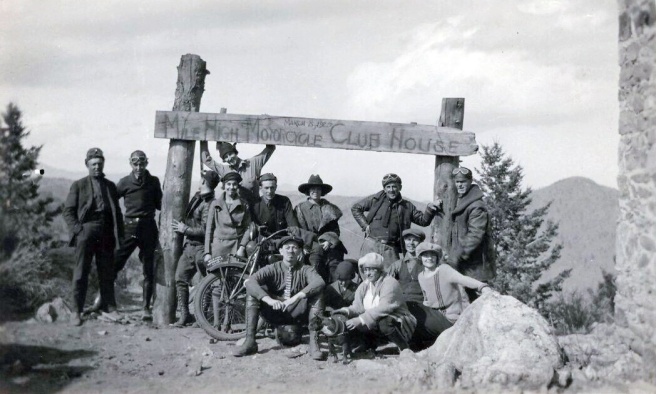
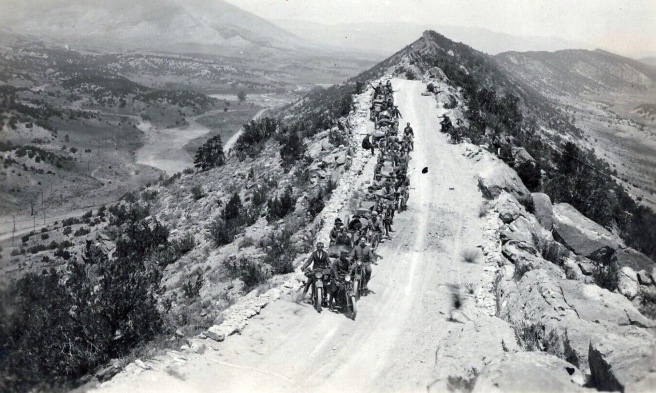
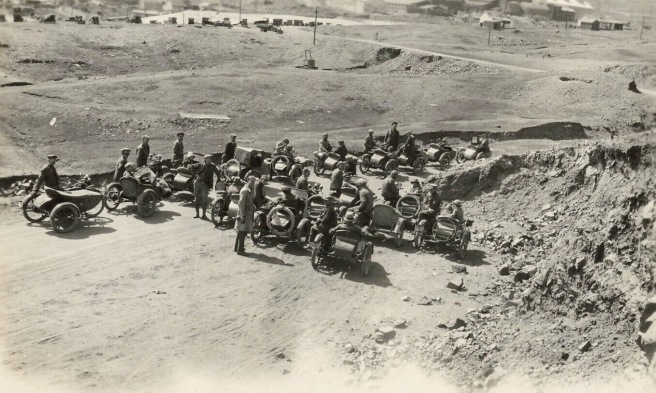
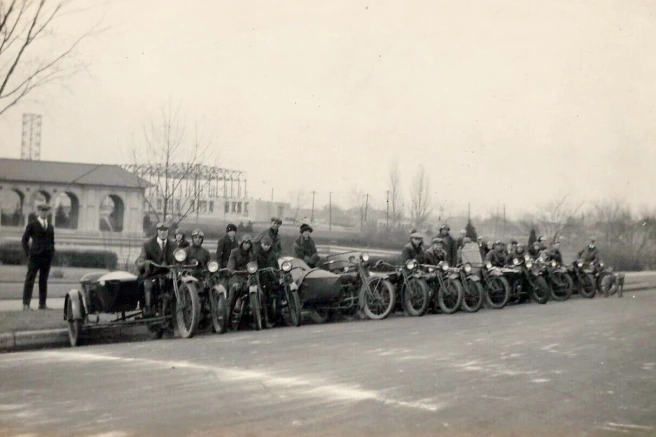
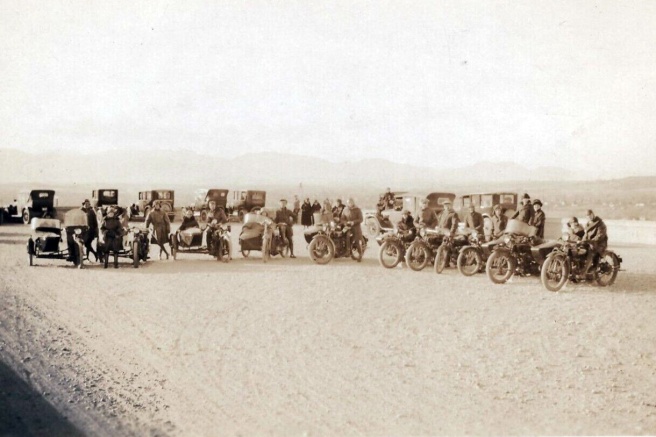
KING ALBERT OF BELGIUM took delivery of his fifth bike, a Jeecy-Vea, which was Belgian built but powered by a British Coventry-Victor flat-twin engine.
HUMILIATION FOR THE FRENCH in their GP with AJS, Norton and Douglas 1st, 2nd and 3rd in the 500cc class ahead of the Peugeot vertical twins. AJSs were 1st and 2nd in the 350cc race, with Jack Stevens ahead of his team-mate Jack Hollowell. Stevens sportingly insisted that he had been credited with a lap too many and Hollowell had won but the French officials sniffily refused to accept this so the result stood.




THE GRAND PRIX DES NATIONS at Monza was run in foul weather which forced a number of retirements. Tazio Nuvolari won the 350cc class for Bianchi, followed home by two more Bianchis. In sixth place was German newcomer Ernst Henne in his first race outside Germany. His performance caught the attention of BMW; it was the start of a beautiful friendship. The 500cc race was won by a GR, an ohv JAP-engined special riden by Count Mario Revelli, ahead of a Moto Guzzi. Revelli’s brother, Count Gino, started building GR road bikes but went under in 1926. The 250cc class, normally an Italian shoe-in, went to Jock Porter’s potent New Gerrard by a six-minute margin.


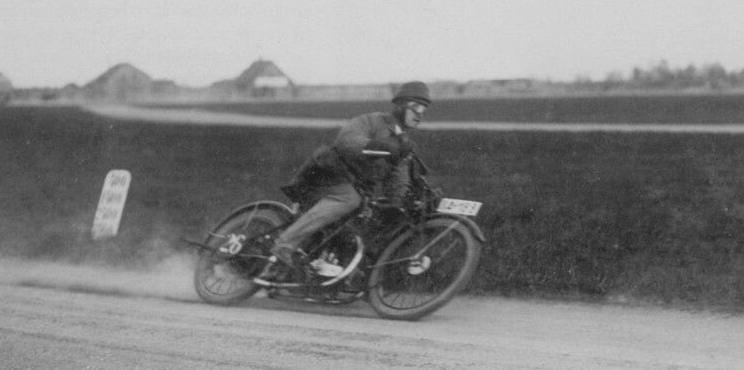
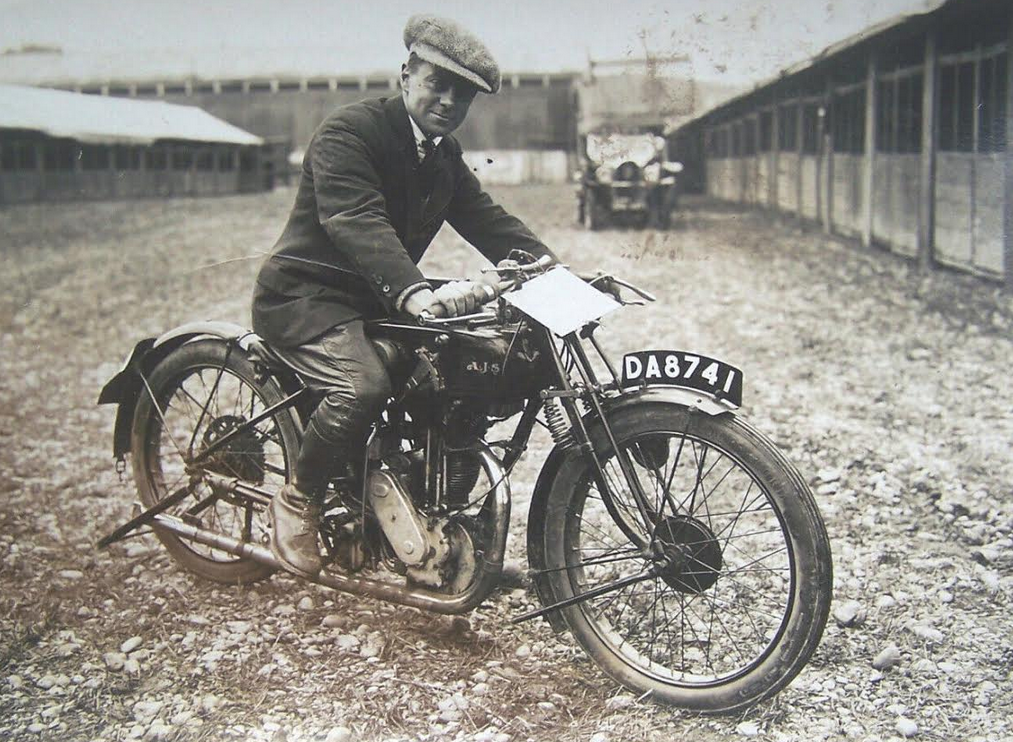
ELSEWHERE BRITISH BIKES continued to make their mark on the Continent. The Spanish Three-Hour 500cc race was won by a Spaniard, but he was riding a Douglas; Sunbeam riders won the Hungarian TTs; while CT Ashby won the 500cc German TT at the Swinemunde circuit on a Panther, setting a race record in the process—and beating a Brough big twin in the 1,000cc class. Ashby also won the 250cc class of the German Grand Prix (on a Zenith) and rode his Panther to a creditable third place in the 500cc class (Alec Bennett won the event on his Norton).
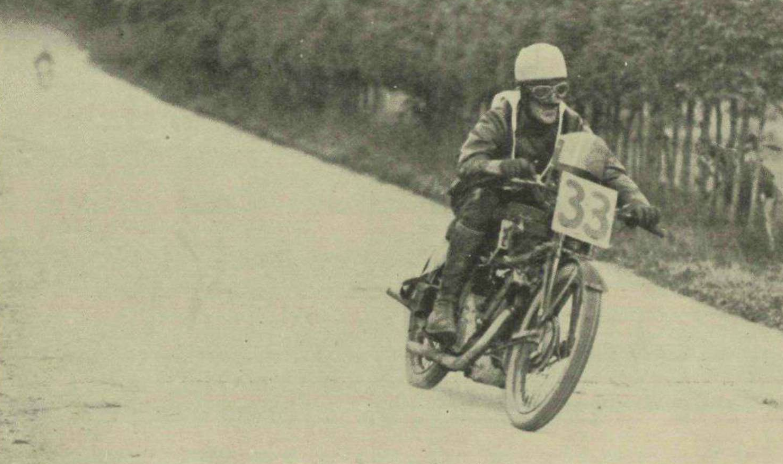
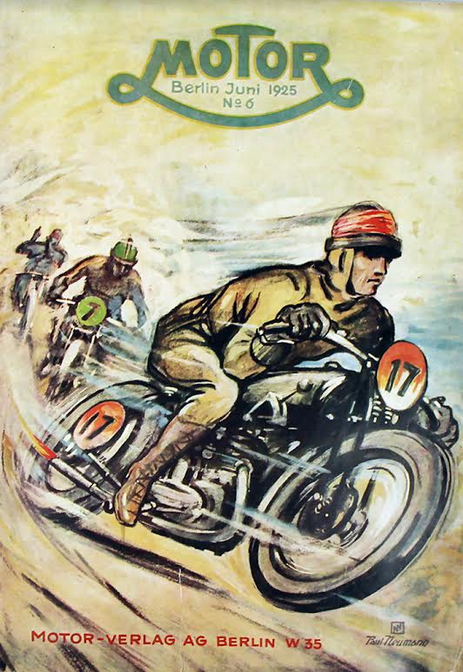
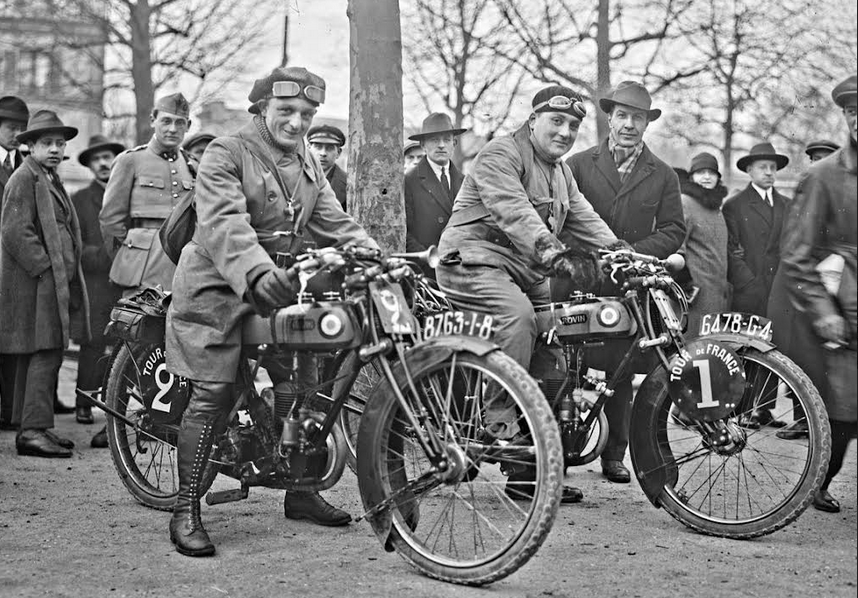
ULSTERMAN JOE CRAIG, who would earn an awesome rep as a Norton tuner, won the 500cc clas of the Ulster Grand Prix for Norton. Royal Enfield took 350cc honours and Cotton won the 250cc class.
FOLLOWING A TECHNICAL VICTORY in the 1924 Belgian ISDT Britain finally got to host the event. The Norwegians had made the best performance in Belgium but had to be content with a lesser trophy because they had failed to ride bikes made in their own country (Norway didn’t produce bikes). They crossed the Channel determined to do it again. Other teams came from Germany, the Netherlands—and, for the first time, Australia. The course started at Southampton docks, which was certainly convenient for the overseas contingent, and headed through the South-West taking in soe of the toughest hills in the country before concluding with special tests and a high-speed thrash round Brooklands. An Aussie newspaper, the Adelaide Register, reported: “Information received by Wyatt Motoria, Grenfell street, the South Australian distributors of AJS motor cycles, is that AJS machines swept the board in the international six days’ trial, contested in England from August 17 till 22. Early reports of the severe test showed that the representatives of all other countries failed to continue, and during the final two or three days only the British and Australian teams were left in the
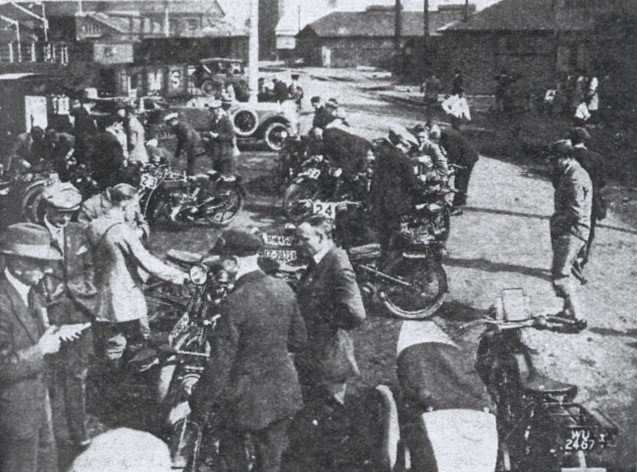
running. Most motor cyclists who have followed the racing career of several of the contestants were aware of the fact that AJS machines were well represented in the finishing number, but few anticipated the eventual scoop. The cable from AJ Stevens, Limited, Wolverhampton, England, read as follows: ‘AJS sweeps the board, winning 350cc team prize and ACM Exhibition medal. Riders: JH Simpson, GE Rowley, and SM Williams. FW Giles and his 498cc sidecar combination recorded the best performance of any passenger machine and was the only one to lose no points. Giles was a member of the British team which gained the international trophy and international vase. The New South Wales team representing Australia (SM Williams, 349cc; AW Gregory, 498cc; and AG Stratford, 498cc) recorded best performance of any overseas team, and were the other team to finish.'” As well as the Blue ‘Un and Green ‘Un, the ISDT was covered by Motorsport magazine: “Although not a ‘sporting event’ in the strict interpretation of the term, the International Six Days’ Trial calls for more than passing comment as being one of the most strenuous events organised

up to the present time. Eliminating the trade element, which naturally forms the greater part of the entries for such a trial as this, we find it becomes an ultra sporting event for private competitors, the severity of which may be judged by frequent remarks as to the danger of fixing the average speed at 20mph. In fact, for sheer continuous excitement nothing could have surpassed Tuesday’s run when, with practically no main roads upon which to make up time, the route went along narrow winding lanes, up and down alarming gradients to say nothing of other baulks in the shape of cattle, lorries and occasional steam rollers. The solo riders were the more fortunate, for they always had the chance of turning into a hedge or ditch, but the lot of the sidecar drivers was often very hard and extremely cautious driving was the order of the day, which left little or no margin for maintaining the average speed. The trial commenced from Andrews’ Garage, situated at Southampton Docks, which was perhaps just as well for some of the foreign competitors
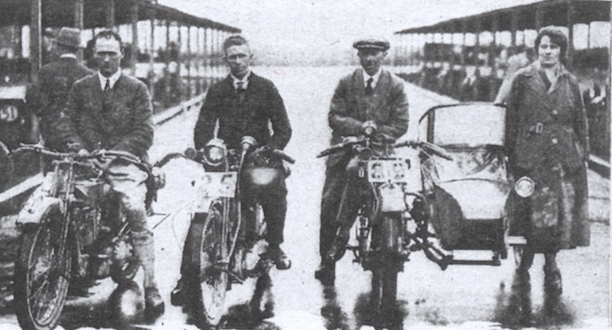
who decided to do a little more tuning before the actual start. The air was filled with the bark of the Villiers’ engines fitted to some of the German machines, and all the riders appeared to be very excited and anxious. When J Herzogenrath arrived late with an OEC-Blackburne complete with open exhaust and no front stand, he soon discovered it would be necessary to do some very quick thinking in order to get ready for the start. The night was a very busy one for the German team and after much telephoning the required parts arrived next morning in time to be fitted. Considering this rider knew no English at all, it is surprising how he managed to get through the first two days. He got absolutely lost at the top of King’s Settle, thinking be was much further on the course. It is to be recorded that he and all other Continental visitors rode throughout in a very sporting spirit, and the writer who had to pass and re-pass continually was always given plenty of road, even by Moldenhaver, who was handicapped by his right-handed sidecar. This Norwegian was riding a Harley-Davidson with a flexible sidecar, and though some efforts were made to discourage him to attempt Lynton, he was quite optimistic, but nevertheless his machine proved very difficult to handle in the
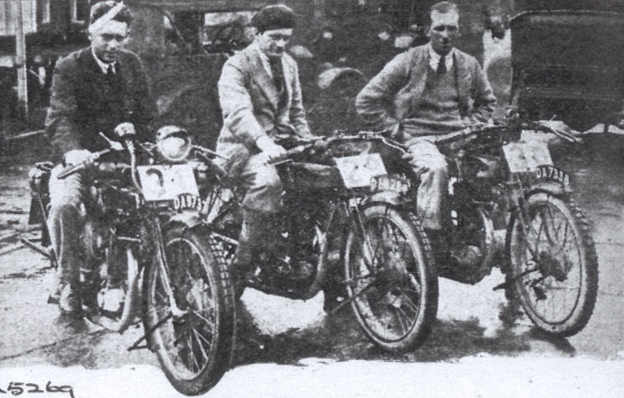
rough. Of the eleven German entrants, six at least had retired by Tuesday, which was unfortunate, but, as their press representative remarked: ‘We do not have such hills in our country.’ That is to say, they choose easier courses for their trials. Other foreign entries of interest were the D-rad machines and the Neanders, both of German origin. The former were very well driven and only one was observed to fail their sturdy construction appearing to be ideal for the conditions of the course. A Viktoria sidecar, a Solo NSU and a Gillet completed the German entries. Australia pinned its faith to the AJS machines, the Dutchmen rode BSAs and the Norwegians had two Harley-Davidsons and an Indian Chief. Sunday turned out as a day of surprises, for who would have expected to find Heath astride an SS 100, Longman on a Panther, or Belfield on a two-speed Scott? Miss Cottle, Miss Foley and Miss Ball were all on their usual mounts, but Hugh Gibson was riding a solo ohv Raleigh, and with Cathrick (Dunelt) was unfortunate in having to retire by reason of indisposition on Tuesday. Monday’s run started off fairly mildly, nothing of any consequence being noticed until Middle
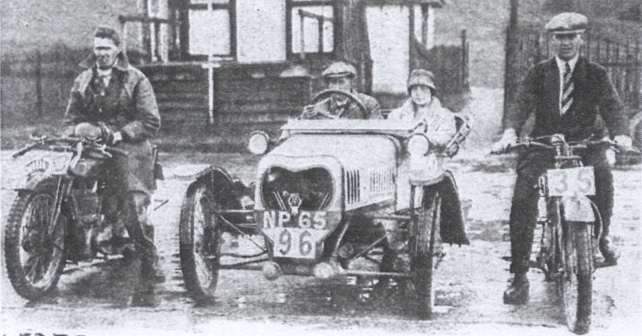
Down Hill was reached. Here there was some first-class team work, the Panthers, James and Royal Enfields going up in single file and only a yard or so apart. The cloud of smoke raised by Himberg (Neander) was rather distressing to some of the early competitors, as it obscured the hairpin bend entirely for a while. King’s Settle Hill, a picturesque landmark crowned by Alfred’s Tower, proved the undoing of three competitors, and the next hill—a sharp rise out of Bruton village for 50 yards—meant a quick change into bottom gear if failure was to be avoided. After lunch at Shepton Mallet everyone had checked in except No I, Bahr (Neander), who had crashed. Another crash was reported, but this turned out to be a non-competitor who had rammed an official car. In the afternoon Draycott Hill proved a long and trying climb, the gradient of 1 in 5 combined with a vile surface accounting for many failures; none of the British machines failed, however, which was partly due to correct judgment in selecting the best ascent and skilfully avoiding the loose portions. Draycott proved an excellent test for the machines, as after some 30 miles running in intense heat, the engines had a stiff job in front of them. Wedmore, the next climb, proved very deceptive, and though the percentage of bad failures was small, good driving was essential if the turn at the top was to be taken in correct style. At the summit a
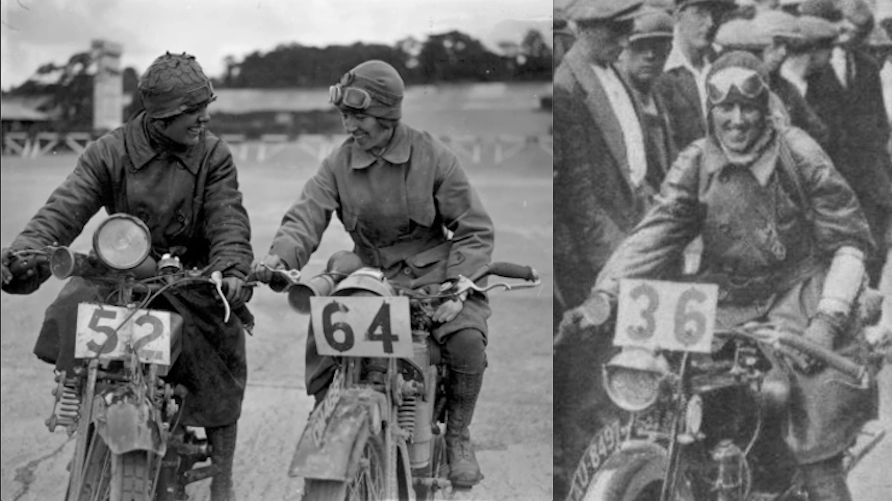
regrettable incident, when Bullus (Panther) unaccountably upset the veteran Raleigh rider, GJ Hamer, of Holland. He was severely injured in the thigh, but first aid was immediately forthcoming from a nearby cottage. [We’ll never know what Hamer thought of The Motor Cycle’s description of Bullus as “quite one of the pretiest riders in the trial”.] Tuesday’s run began in almost tropical heat and the entire day was spent in traversing endless lanes, grass-grown tracks, steep ascents and alarmingly sudden descents arranged in quick succession. In the morning the famous hills of the past were climbed and here failures were few and far between, Porlock, Lynton and Beggars’ Roost all seeming quite simple for modern engines when the surface is dry. The ascent of Dunkery Beacon, the top of which was veiled in mist, was long and tortuous, small gullies and large stones helping the gradient to call forth great skill. A hundred cars and odd vehicles were assembled at Beggars’ Roost and an enthusiastic audience cheered again and again as the famous hill was conquered by most of the riders, but it was not until Tuesday afternoon that the real piece de resistance of the whole trial came into view. Rising approximately 800ft in about half a mile, completely bestrewn with small boulders, Fingle Bridge is undoubtedly an excellent test for the modem motor cycle. The bends and twists are so numerous as to cause one to lose count, all one’s attention being needed to manoeuvre one’s machine over the surface, which only compared with the rocky bed of some mountain stream. Here some of the most experienced riders were seen to throw out a tentative leg and the banks were struck by several riders who bounced off large pieces of rock. When this happened there was little chance of recovering as frantic wheel spin ensued and the unfortunate riders would find it impossible to continue the climb. It is good to observe that the majority effected good ascents, the performance of Sibley, on the Rudge, deserving particular praise, for, in spite of one stop, he managed to reach the summit with plenty of revs,

if not too much wheel adhesion. Those who fancied Fingle Bridge to be the conclusion of the day’s entertainment were mistaken, for the course continued over miles of rough ground until the main road was eventually reached at Wellington. Near the latter place a Matchless sidecar collided with a lorry, thus blocking the lane, so that for a long period all the sidecars were delayed, thus causing them to be caught in a violent thunderstorm., which certainly had the effect of washing away some of the dust the riders had collected during the day. At the conclusion of the day’s run the absence of WA Bouette was discovered, and it appeared that he had crashed near South Molton. On Wednesday the weather broke entirely and what should have been a delightful journey turned out as a London-Exeter over the Welsh mountains. At the moment of going to press the trial is still in progress…” A-Z of ISDT mounts: Six AJSs, four Ariels, two Brough Superiors, ten BSAs, five Douglases, three D-Rads, two Dunelts, three Harleys, one Gillet, three Humbers, one Indian, four James, five Matchlesses, one Morgan, three Neanders, one New Gerrard, four New Hudsons, one New Imperial, one Norton, one OEC-Blackburne, one OK, four P&Ms, six Raleighs, three Royal Enfields, one Rudge, one Sarolea, two Scotts, two Sunbeams, one Triumph, one Velocette, one Victoria and one Zenith. Results: Of the 85 starters 36 won gold medals, 12 silver and three bronze. Great Britain’s ‘A’ Team, GS Arter (499cc James), B Kershaw (346cc New Hudson) and FW Giles (496cc AJS otfit), won the International Trophy and the International Silver Vase. The ACU East Midlands Centre team, AE Rollason (498cc Ariel), WA Carr (1,075cc Morgan) and L Crisp (498cc Ariel) won the British Motor Cycling Championship. AJS (JH Simpson, GE Rowley and SM Williams) won the 350cc class of the Manufacturers Team Prize. James (GS Lister, G Kimberley and J Lidstone) won the 500cc class.
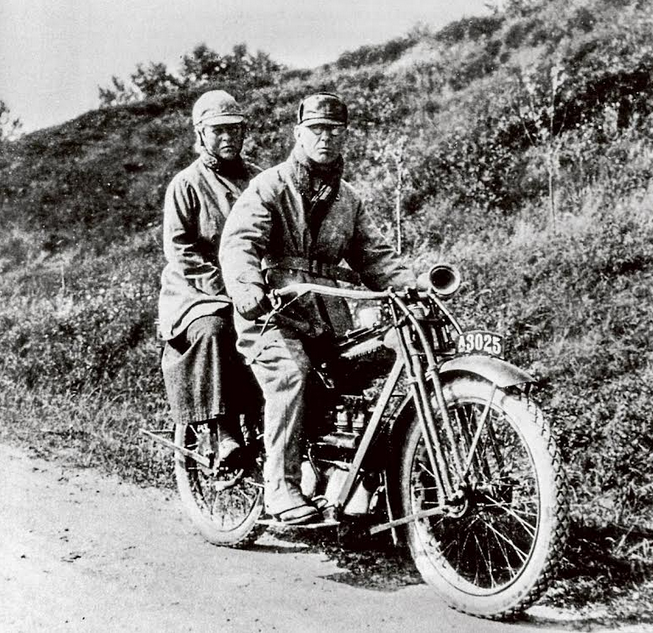
A GROWING NUMBER OF MACHINES were appearing with four-speed transmissions. Straight-tube forks, notably Brampton and Webb, were rapidly replacing curved fork legs; electric lights were superseding gas; drum brakes were driving out the old bicycle-style rim brakes. George Brough offered the option of spring frames.
BRITAIN PRODUCED 120,000 MOTORCYCLES, compared with 55,980 in Germany and 45,000 in the USA. British registrations reached 581,222 by year’s end; motorcycle exports totalled £2,870,534 (about £200m today).


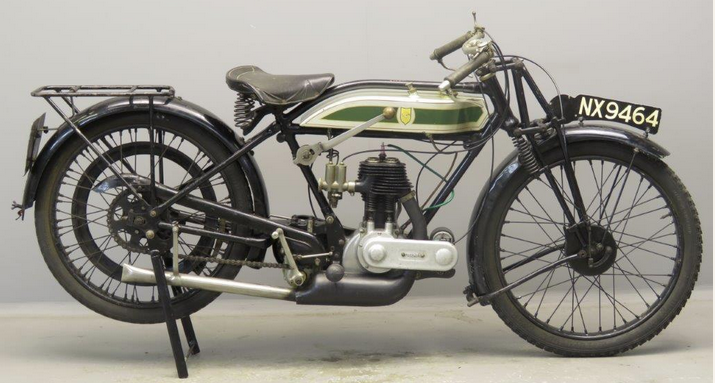
UNDER THE WINCE-INDUCING headline ‘Triumph Of Horsman’ the Adelaide Register reported: “The recent series of scratch races held at Brooklands showed that [Victor] Horsman had his Triumph in good order. The Motor Cycle reports: ‘The 500cc scratch race was just a duel—but what a duel—between Judd and Horsman, who moved together as if linked with some magnetic force. Even when Judd, who was behind, sprinted magnificently to gain the 10 yards necessary to let him win, he could not draw out of the five-yard circle in which the duellists had been manoeuvring for three laps. His wins secured him two world’s records in Class C, and it is odd to think that just five yards deprived Horsman of the same records.’ Horsman on his Triumph worried and beat Temple in the 1,000cc scratch race by half a lap. Despite beautiful riding on the part of Temple, his big twin was unable to pass the flying single. Horsman again carried all before him in the five-lap all-comers’ handicap, even to increasing his speed of the former race by 2½ miles an hour. The exhibition given by Horsman on that occasion places him in the front rank of the world’s riders.” Triumph paid Horseman £1,500 for his design (he also uprated the frame) and put it into series production.
VIC WILLOUGHBY, TECHNICAL EDITOR of The Motor Cycle wrote : “When, in 1925, Velocette took the bold step of switching straight from small two-strokes to a high-performance overhead-camshaft three-fifty, that Model K incorporated several unusual design features. These were not only justified by almost instant success [victory in the 1926 Junior TT]; they also stayed basically unchanged until production of that most famous of all ohc Velocettes, the KTT racer, ceased in the early 1950s. Among the unusual features was an in-board primary drive, which left the gearbox final-drive sprocket very accessible for the simplest possible change of overall ratios in racing. More important, it enabled the crankcase to be kept very narrow, with the single main bearings closely spaced and in direct line with the walls of the crankcase and cylinder for really rigid support.” Wiloughby knew cammy Velos better than most: he rode KTTs in the 1948, 1949, 1950 and 1953 Junior TTs (though his best result, 12th in the 1953 Junior, was aboard a Norton).

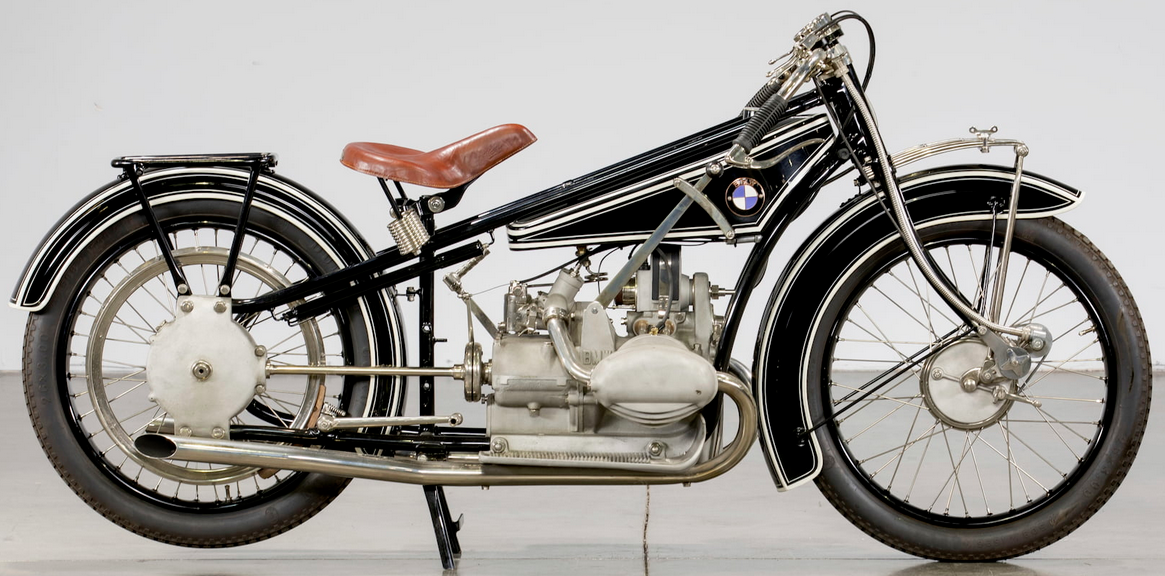

AS THE MAJOR PLAYERS CUT PRICES to the bone smaller marques went to the wall. The second half of of decade would mark the end of the line for BAT, Brady, Beardmore Precision, Hazlewood, Hobart, Martinsyde and McKenzie. Connaught and Quadrant were in their final decline; Clyno, Lea Francis and Rover dropped bikes in favour of cars.
AN ENTHUSIAST NAMED Edward Turner designed and built an ohc 348cc motorcycle which attracted favourable coverage in the Blue ‘Un.
ROAD RACING HAD BEEN BANISHED to the Island and Ulster, but sprints and hillclimbs on closed roads were attracting big crowds until the death of a spectator at Kop Hill, led to a nationwide ban.
ARIEL RECRUITED VAL PAGE from JAP, where he had developed the big V-twins that powered the likes of the BruffSup SS80 and SS100. No wonder Ariel wanted him.
JAPAN OFFERED SUBSIDIES to domestic made vehicles with military applications. The Murata Iron Works and Mazda made unsuccessful Harley clones but the Japanese army was also importing Harleys. Kawamanda Kazuo won the 350cc class in a 100-mile race at Naruo, attractcting the attention of a Harley-Davidson sales rep who recruited him as Harley’s first factory rider in Japan. Within a week Kenzo won the unlimited class at a car and bike race meeting on a 74. Also in Japan, the Kansai MCC staged a 430-mile Tourist Trophy.
BY YEAR’S END about 190 miles of arterial roads had been built in Britain including the first dual-carriageway, the Kingston Bypass, which would be a favourite with the ton-up boys decades later.
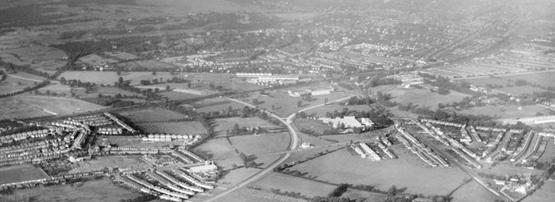

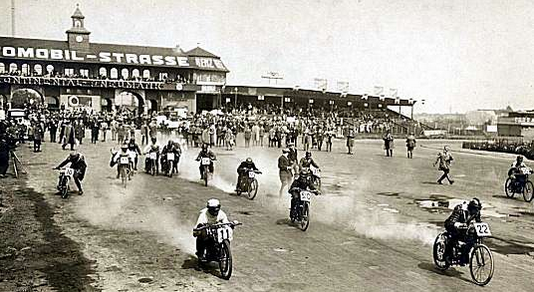

THE FIRST ORGANISED ice race was held on the frozen Eibsee, a lake near Garmisch-Partenkirschen in Germany. It spread, first to other Bavarian lakes, then to Scandinavia and Canada.
TWENTY YEARS AFTER HE PATENTED the first supercharger Alfred Büchi finally ironed out the problems and boosted a four-stroke diesel engine’s power output by 40%: turbo-diesels were soon powering liners; this is the technology that paved the way for supercharged motor cycles.
To mark the 30th anniversay of The Emancipation Run (come on, it was only 40 pages ago) veteran bikes (and cars) headed for the coast, as they have ever since.





Here are some of the ads that helped empty motor cyclists’ pockets in 1925…


